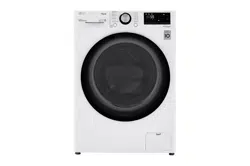Documents: Go to download!
- Owner's manual - (English, French, Spanish)
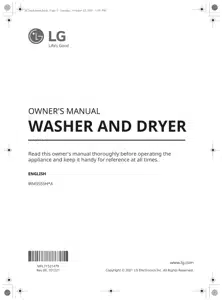
- PRODUCT OVERVIEW
- OPERATION
- MAINTENANCE
- TROUBLESHOOTING
Table of contents
Owner's Guide Washer & Dryer
PRODUCT OVERVIEW
Front View
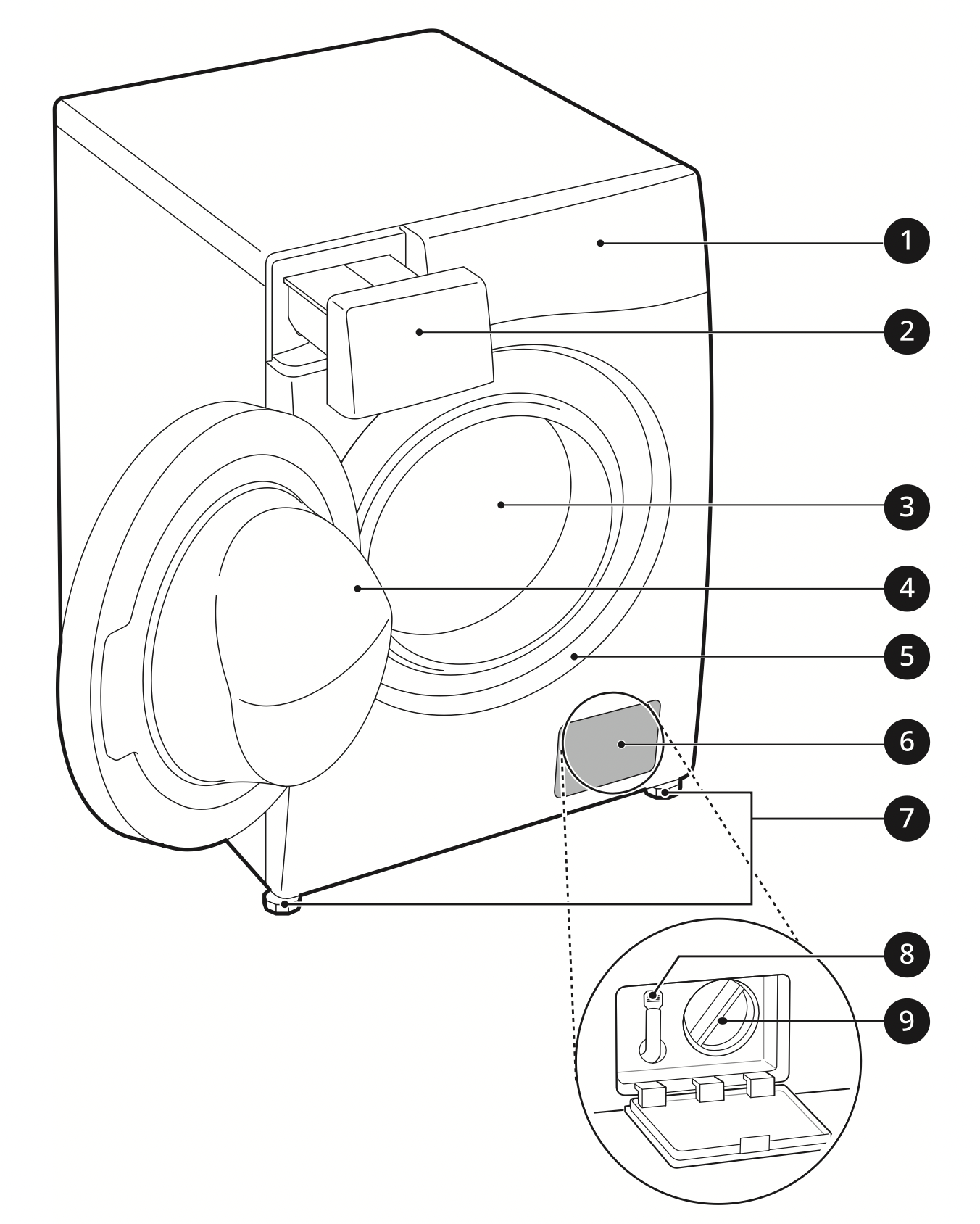
- Control Panel
- Detergent Dispenser Drawer
- Drum
- Door
- Door Seal
- Drain Pump Filter Cover
- Leveling Feet
- Drain Hose
- Drain Pump Filter
Rear View
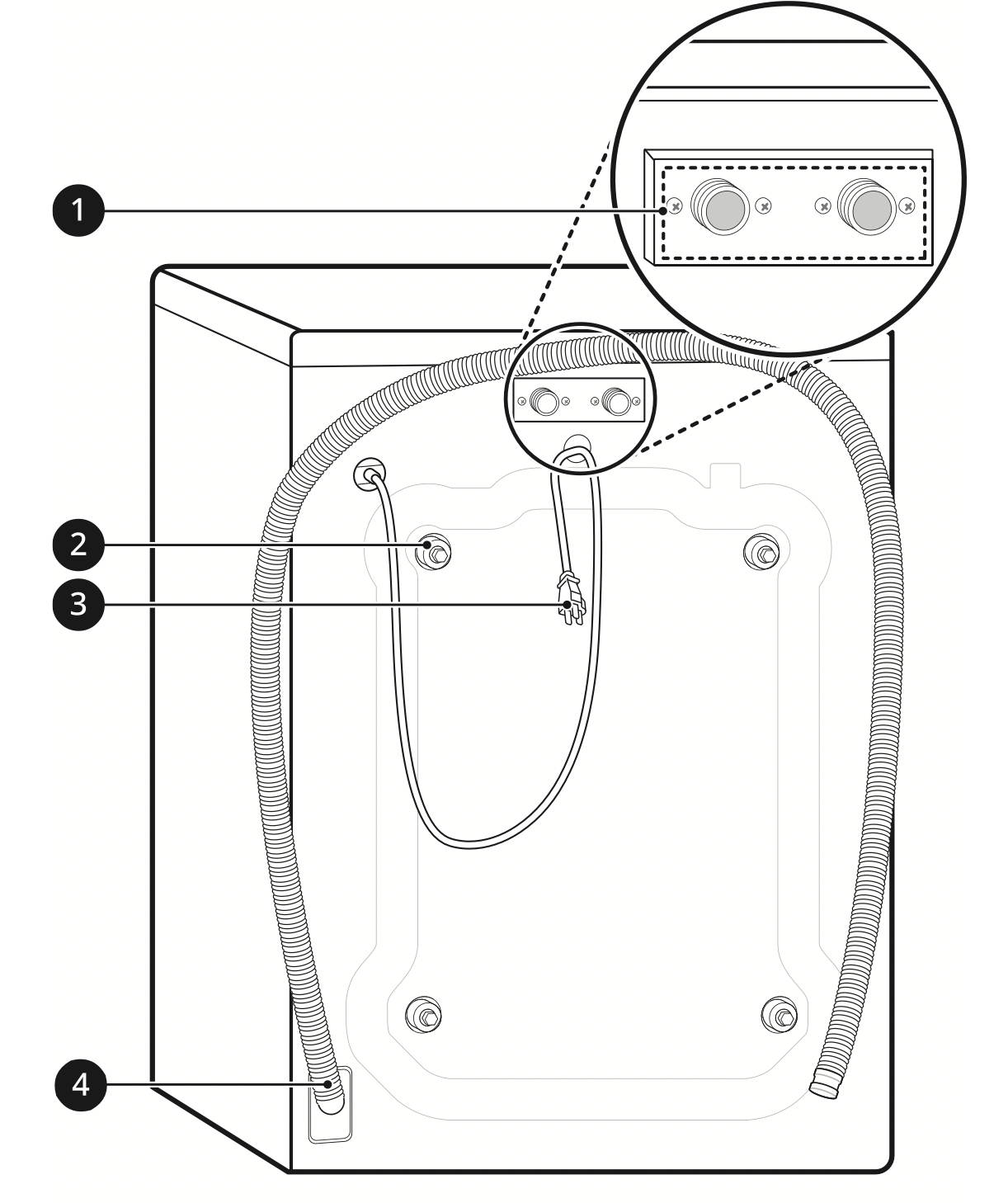
- Water Inlets
- Shipping Bolts
- Power Cord
- Drain Hose
OPERATION
Before Use
WARNING: To reduce the risk of fire, electric shock, or injury to persons, read the SAFETY INSTRUCTIONS before operating this appliance.
Operation Overview
1. Sort laundry and load the washer.
- Sort laundry by fabric type, soil level, color and load size as needed. Open the door and load items into the washer.
- If using single-use detergent packs, or gel or tablet detergents, place them in the drum before loading the laundry.
2. Add cleaning products.
- Add the proper amount of HE (High-Efficiency) detergent to the detergent dispenser.
- If desired, add bleach or fabric softener to the appropriate areas of the dispenser drawer.
- Do not place liquid or powdered detergent packs, or gel or tablet detergents in the dispenser.
3. Turn on the washer.
- Press the Power button to turn on the washer.
4. Select a cycle.
- Turn the cycle selector knob or press the cycle buttons repeatedly until the desired cycle is selected.
- The preset wash temperature, spin speed, soil level and option settings for the selected cycle are shown.
- The Normal cycle must be selected in order to change its default settings.
- Pressing the Start/Pause button without selecting a cycle immediately starts the Normal cycle with the default settings.
5. Adjust settings.
- Default settings for the selected cycle can be changed, if desired, using the cycle modifier and option buttons.
- Not all modifiers and options are available on all cycles. A different chime sounds and the LED does not light up if the selection is not allowed.
6. Begin cycle.
- Press the Start/Pause button to begin the cycle. The door locks, and the washer agitates briefly without water to measure the weight of the load.
- If the Start/Pause button is not pressed within a certain time, the washer shuts off and all settings are lost.
7. End of cycle.
- When the cycle is finished, a melody sounds. Immediately remove the clothing from the washer to reduce wrinkling.
- Check around the door seal when removing the load for small items that may be caught in the seal.
NOTE:
- The washer rotates the laundry in a way that allows it to use less water while still fully saturating the clothing. It is normal to be unable to see water during the wash cycle.
- If the temperature or the water level inside the machine is too high, the door locks and cannot be opened.
Sorting Laundry
CAUTION
- Clothing or articles that are waterproof or water-resistant must be washed in the Waterproof, Bedding, Bulky/Large, or Jumbo Wash cycle only. (Examples include water resistant clothing, mattress covers, outdoor clothes, and plastic mats.) Failure to do so may result in personal injury or damage to the washer, clothes, walls, floor, and surrounding objects due to abnormal vibration.
- Remove the stuffing from pillows and cushions before washing the covers. Failure to do so can cause excessive vibration, resulting in damage to the washer, clothes, nearby objects, walls, and floor.
Grouping Similar Items
For the best washing results, and to reduce the possibility of damage to clothing, sort clothing into loads made up of similar items.
Mixing different fabric types and/or soil levels can result in poor wash performance, color transfer, discoloration, fabric damage or linting. Fabrics should be sorted into groups as described below.
Colors
Sort articles by color. Wash dark clothes separately from light colors or whites. Mixing dark clothes with light clothes can result in dye transfer or discoloration of the lighter clothes.
Soil Level
Wash heavily soiled clothing together. Washing lightly soiled clothing in the same load with heavily soiled clothing could result in poor wash performance for the lightly soiled clothing.
Fabric Type
Delicate articles should not be mixed with heavy or sturdy fabric types. Washing heavy fabrics with delicates can result in poor wash performance for the heavy fabrics and possible damage to the delicates.
Lint Type
Some fabrics attract and bind lint to them while others give off lint in the laundry process. Avoid mixing these lint collectors and lint producers in the same load. Mixing these fabrics will result in pilling and linting on the lint collectors. (For example, lint collector - knit sweater; lint producer - terry cloth towels.)
How to Sort Laundry


Fabric Care Labels
Many articles of clothing include a fabric care label. Using the chart below, adjust the cycle and option selections to care for your clothing according to the manufacturer’s recommendations.

Loading the Washer
CAUTION: Clothing or articles that are waterproof or water-resistant must be washed in the Waterproof, Bedding, Bulky/Large, or Jumbo Wash cycle only. (Examples include water resistant clothing, mattress covers, outdoor clothes, and plastic mats.) Failure to do so may result in personal injury or damage to the washer, clothes, walls, floor, and surrounding objects due to abnormal vibration.
General Tips
- Check and empty pockets. Paper clips, coins, matches, and other items can damage clothing and the washer.
- Close zippers and hooks, and tie drawstrings to prevent snagging or tangling of clothes.
- Pretreat heavily stained areas for best results.
- Brush off heavy soil, dust, and hair from items before washing. Excess dirt or sand can abrade other fabrics and lead to poor wash performance.
- For best performance, load clothes as shown.
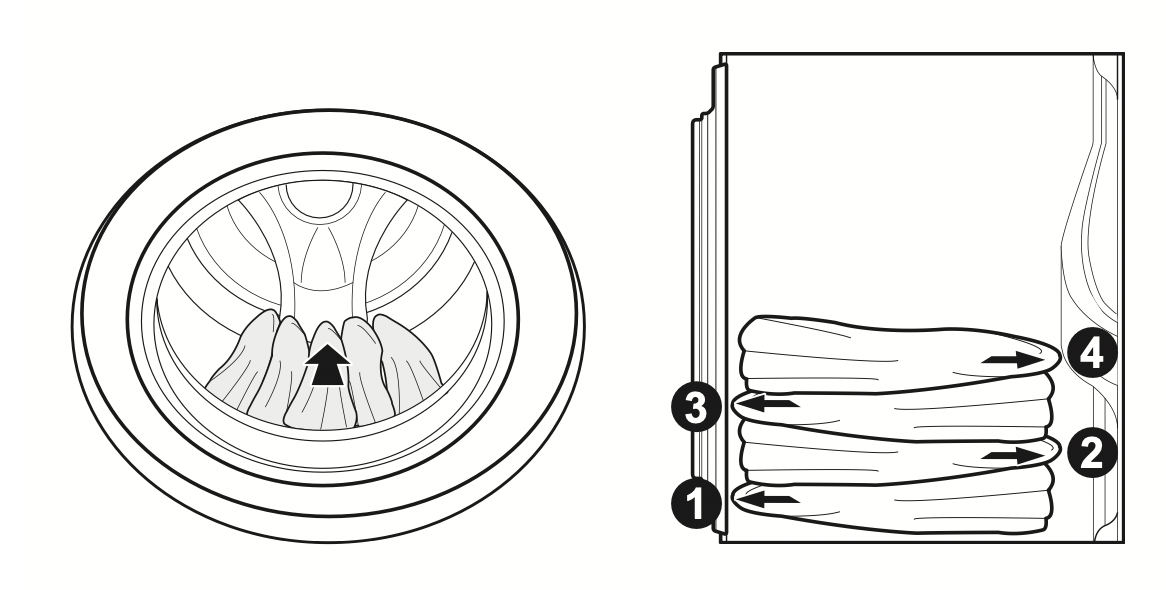
- Do not press down on items while stacking them in the drum.
- Load clothes loosely, and do not overfill the drum. Clothes need room to circulate in order to get clean.
- Combine large and small items in the drum.
See other models: 34BP65C-B LK75C DLHC1455P A939KBGS GSLV50DSXM
Load large items first. Large items should not be more than half of the total load. - The washer can be fully loaded, but the drum should not be tightly packed with items. The door of the washer must close easily.
- The washer will not fill or operate with the door open.
Bulky Items
- Wash thick, bulky items individually. Heavy blankets, comforters, bedspreads, or pet beds can get tangled or cause an unbalanced load if combined with other items.
Small Items
- Do not wash a single small item. Add enough similar items to the load to prevent an out-ofbalance load.
- Wash small, light items in a mesh bag. Small items can get caught in the impeller at the bottom of the drum, and brassiere hooks can snag on other clothing or the drum.
Adding Cleaning Products
About Detergent Use
This washer is designed for use with only HE (HighEfficiency) detergents.
- HE detergents produce fewer suds, dissolve more efficiently to improve washing and rinsing performance, and help to keep the interior of the washer clean. Using detergent that is not HE may cause oversudsing and unsatisfactory performance which could result in error codes, cycle failure, and washer damage.
- Detergents designated as HE-compatible may not provide optimal results.
- For proper wash performance, always measure detergent using the measuring device provided by the detergent manufacturer. For an average load, use less than half of the recommended maximum. Use less detergent for soft water, light soil, or smaller loads.
- Use extra care when measuring 2X and 3X concentrated detergents because even a small amount of extra detergent can lead to problems.
- Never use more than the maximum amount of detergent recommended by the manufacturer. Using too much detergent can lead to oversudsing, poor rinsing, detergent buildup in clothing, and residue buildup that can contribute to odors in the washer.
- Do not use more than one single-use detergent pack in the washer. Using too much detergent may cause oversudsing and unsatisfactory performance. Reduce detergent amount or add an extra rinse if detergent residue is left on fabrics. To add an extra rinse, select the Extra Rinse option.
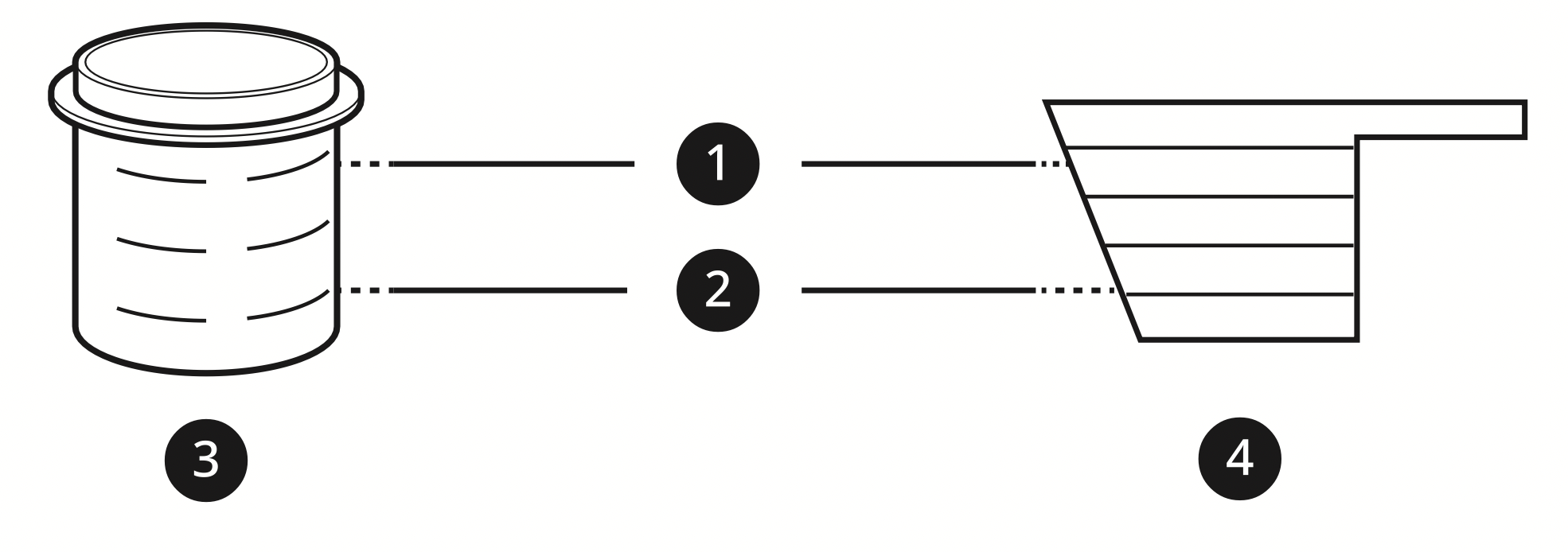
- Maximum fill line
- Average load fill line
- Liquid detergent
- Powdered detergent
Single-Use Detergent Packs / Gel or Tablet Detergents
Place liquid or powdered detergent packs, or gel or tablet detergents in the drum before loading laundry. Do not place these detergents in the dispenser.
Using the Dispenser
To add cleaning products to the automatic dispenser:
- Open the dispenser drawer.
- Load the laundry products into the appropriate compartments.
Follow the manufacturer’s recommendations when adding cleaning products.
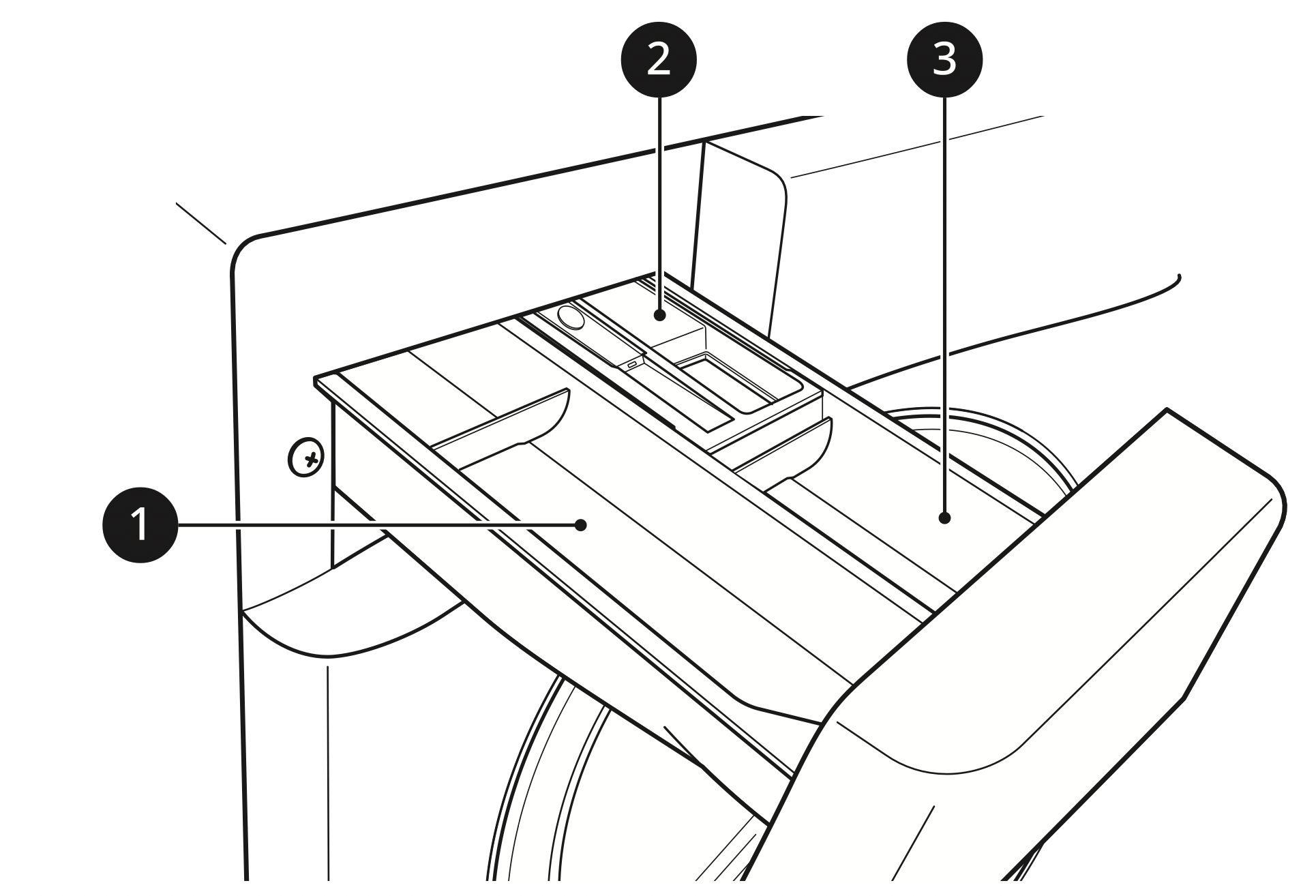
1. Main wash detergent compartment
2. Liquid fabric softener compartment
3. Pre-wash detergent compartment - Gently close the detergent dispenser drawer before starting the cycle.
Slamming the drawer closed may result in the detergent overflowing into another compartment or dispensing into the drum earlier than programmed.
Be careful not to get a hand caught in the drawer while closing.
It is normal for a small amount of water to remain in the dispenser compartments at the end of the cycle.
CAUTION: Do not place or store laundry products, such as detergent, bleach, or liquid fabric softener, on top of your washer. These products can damage the washer’s finish and controls.
Main Wash Detergent Compartment
This compartment holds laundry detergent for the main wash cycle. Either powdered or liquid detergent may be used in this compartment.
- The detergent is added to the load at the beginning of the cycle. Always use HE (HighEfficiency) detergent with your washer.
- Do not exceed the maximum fill line. Using too much detergent can result in detergent buildup in clothing and the washer.
- Liquid or powdered color-safe bleach may be added to the main wash compartment with detergent of the same type. Do not mix liquids and powders
- If the dispenser has a liquid detergent cup and insert:
- Make sure they are in place when using liquid detergent.
- Make sure to remove them when using powdered detergent. Powdered detergent will not dispense with the liquid detergent cup and insert in place.
- When using powdered detergent, remove the insert and liquid detergent cup from the dispenser. Powdered detergent will not dispense with the liquid detergent cup and insert in place.
- If you use a detergent that does not dissolve easily or a detergent with high viscosity, it will leave a residue and clog the dispenser.
Fabric Softener Compartment
This compartment holds fabric softener, which is automatically dispensed during the final rinse cycle. Either powdered or liquid fabric softener may be used.
- Do not exceed the maximum fill line. Using too much fabric softener may stain clothes or cause buildup on fabrics or in the washer.
- Dilute concentrated fabric softeners with warm water.
- Never pour fabric softener directly onto the load or into the drum.
Pre-wash Detergent Compartment
Add liquid or powdered detergent to this compartment when using the Pre-wash option. Always use HE (High-Efficiency) detergent with your washer.
- When using the Pre-wash option, liquid detergent for the main wash needs to be loaded in the liquid detergent cup accessory in the main wash dispenser (where applicable), to prevent it from being dispensed with the pre-wash detergent.
- The amount of detergent added for the Prewash option is 1/2 the amount recommended for the main wash cycle. For example, if the main wash cycle requires one measure of detergent, add 1/2 measure for the Pre-wash option.
Control Panel
Control Panel Features
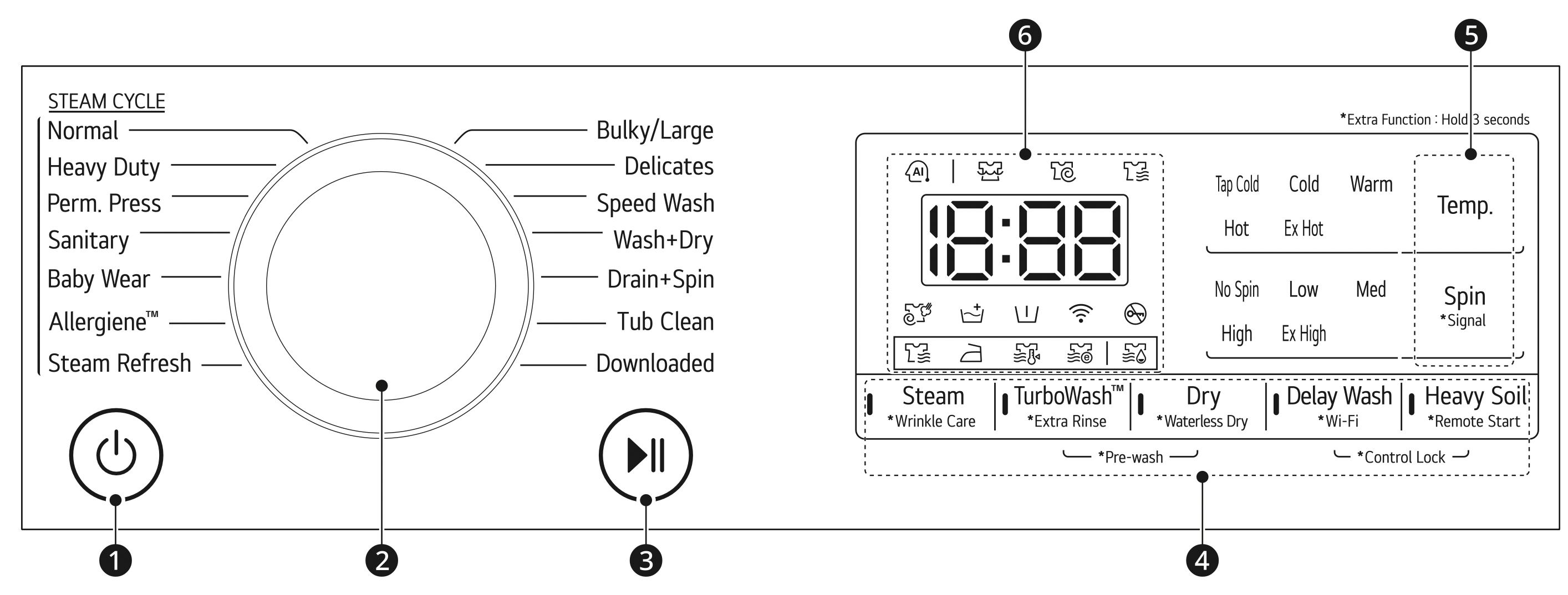
1. Power On/Off Button
- Press this button to turn the washer on or off.
- Pressing this button during a cycle will cancel that cycle and any load settings will be lost.
- The door will unlock after a brief pause.
NOTE: If there is any water remaining in the drum after the washer shuts off, it will drain after a delay. The washer can be restarted at any time before the drain begins. However, once the water begins to drain, all functions will be suspended until the water has been completely drained and the washer shuts off.
2. Cycle Selector Knob
- Turn this knob to select the desired cycle.
- Once the desired cycle has been selected, the standard presets will appear in the display. These settings can be adjusted using the Cycle Modifier buttons at any time before starting the cycle.
3. Start/Pause Button
- Press this button to start the selected cycle.
- If the washer is running, use this button to pause the cycle without losing the current settings.
NOTE: If the Start/Pause button is not pressed to start the selected cycle, after a delay the washer automatically turns off and all cycle settings are lost. Any water remaining in the drum will be drained.
4. Option and Extra Function Buttons
- These buttons allow you to select additional cycle options. Certain buttons also allow you to activate special functions by pressing and holding the button for 3 seconds.
5. Cycle Modifier Buttons
- Use these buttons to adjust the wash temperature, spin speed and soil level settings for the selected cycle.
- The current settings are shown in the display.
- Press the button for that option to select other settings.
6. Time and Status Display
Time and Status Display
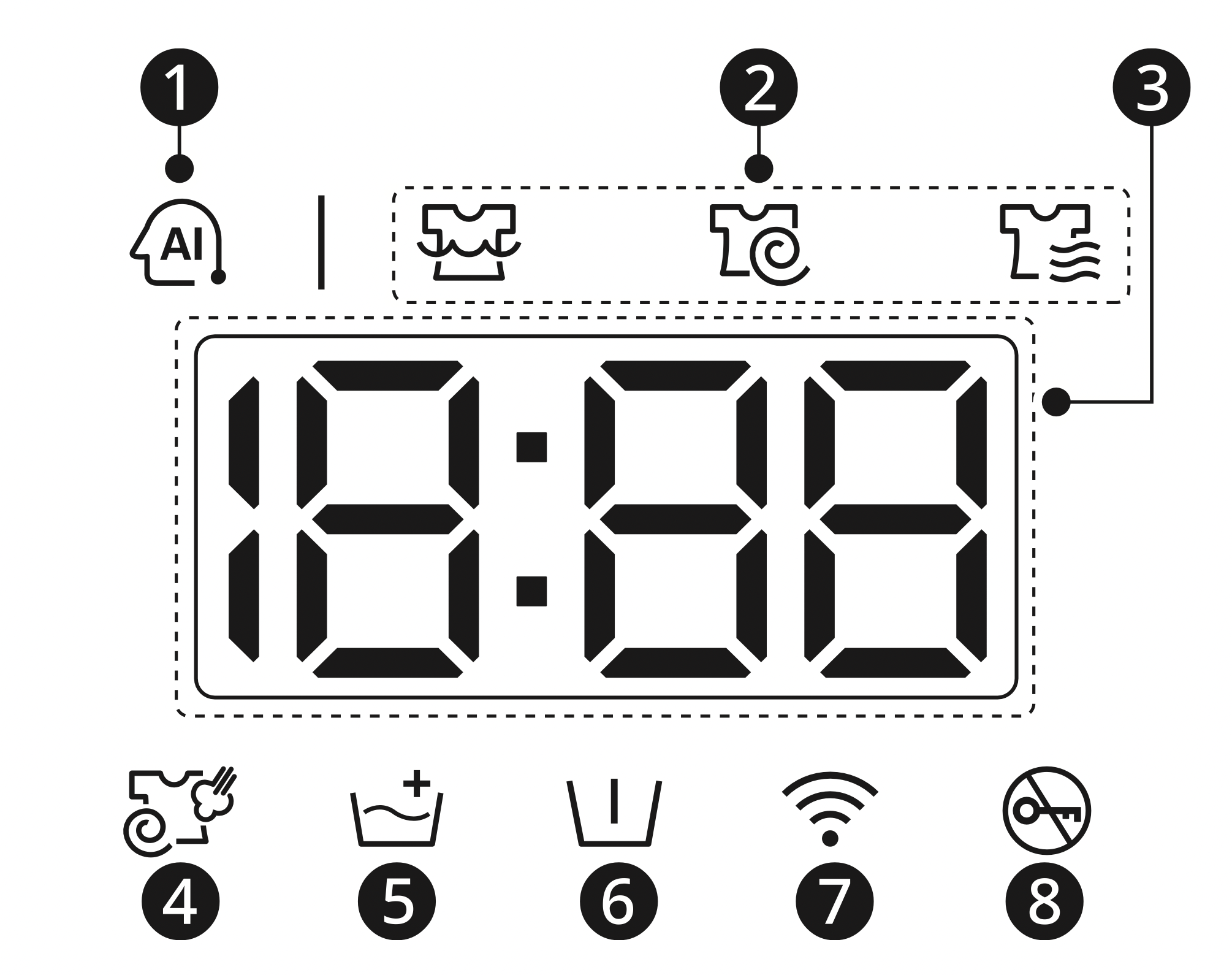
1. AI DD Indicator
- AI DD provides the appropriate drum rotation actions after load sensing is completed.
- This indicator lights up when the Normal cycle is selected and operated.
2. Cycle Status Indicators
- These LEDs will blink when a cycle is selected to indicate which stages will run.
- When a cycle is running, the LED for the active stage will blink, and the LEDs for the remaining stages will remain steady. Once a stage is complete, the LED will turn off. If a cycle is paused, the active stage LED will stop blinking.
3. Estimated Time Remaining
- When a cycle is selected, the default time for that cycle is displayed. This time will change as modifiers or options are selected.
- If the display shows -I--, then the time will be displayed after the load sensing has detected the load size.
- The time shown is only an estimate. This time is based on normal operating conditions. Several external factors (load size, room temperature, incoming water temperature, etc.) can affect the actual time.
NOTE
- Once the Start/Pause button is pressed, the washer will measure the size of the load. The estimated time may change once the load size has been measured.
- If the Delay Wash function is set, the remaining delay time counts down until the cycle begins.
4. Wrinkle Care Indicator
- This indicator lights up when the Wrinkle Care option is activated.
5. Rinsing Indicator
- This indicator lights up when extra rinses are added.
6. Pre-wash Indicator
- This indicator lights up when the Pre-wash option is selected.
7. Wi-Fi Indicator
- This indicator is lit when the product is connected to a home Wi-Fi network.
8. Door Lock Indicator
- This indicator lights up when the cycle starts and the door is locked.
- The indicator light stays on until the cycle is paused, stopped or has finished.
Wash Cycles
The wash cycles are designed for specific types of wash loads. Select the cycle that best matches the load contents for maximum wash performance and fabric care. See Sorting Laundry section for best results, and follow the fabric care labels on your garments. For a guide to fabric care symbols, see Sorting Laundry section.
Cycle Guide
Turn the knob or press the button to select the desired cycle. When you select a wash cycle, the light for the corresponding wash cycle will turn on.
NOTE: Whenever load weights are mentioned, assume 1 lb (0.45 kg) = 1 thick bath towel (dry).






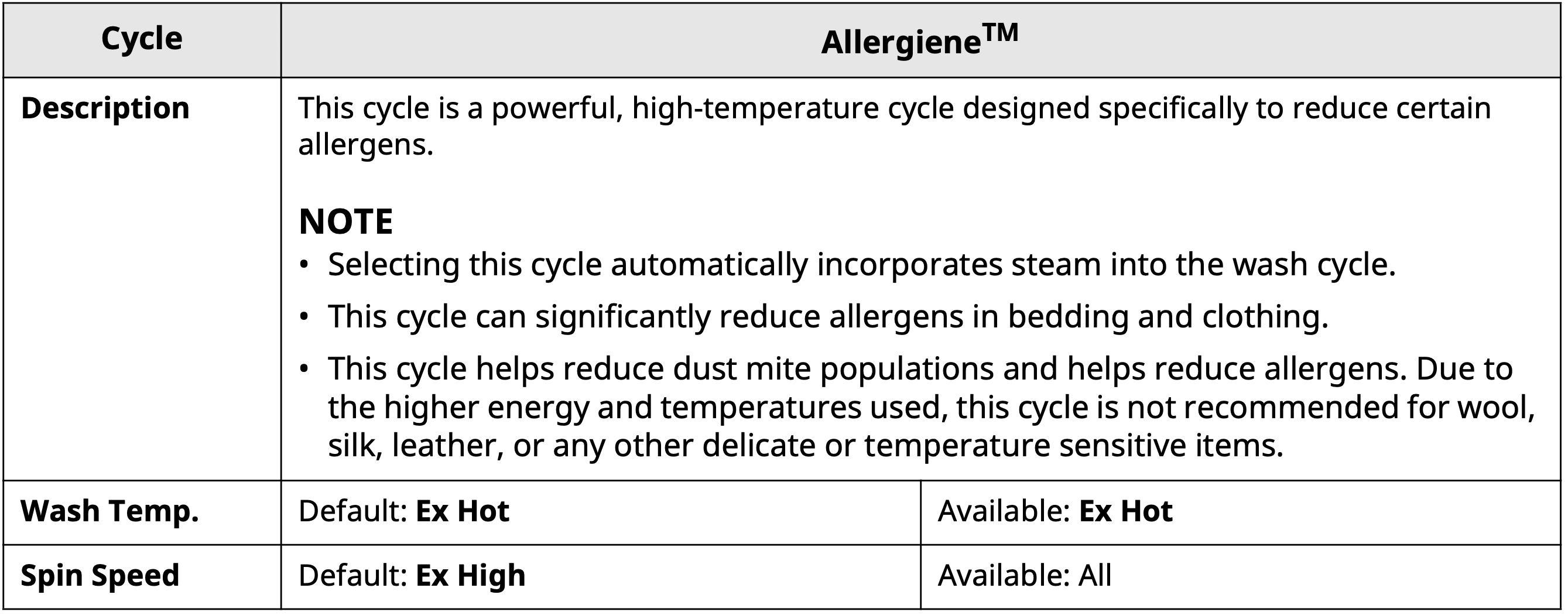









Available Options
† This option is automatically included in the cycle and cannot be deselected.
NOTE
- You cannot select any option in the Steam Refresh cycle.
- For the Drain + Spin cycle, only the Delay Wash option can be selected.
- The Delay Wash, Extra Rinse and Heavy Soil options are available for every cycle in this table.

Cycle Modifiers
About Modifier Buttons
Each cycle has default settings that are selected automatically. You can also customize these settings using the cycle modifier buttons.
- Repeatedly press the button for the desired modifier until the indicator light for the desired setting is lit.
- The washer automatically adjusts the water level for the type and size of wash load for best results and maximum efficiency.
- This is a high-efficiency washer, and the water levels may be much lower than you expect. This is normal, and cleaning/rinsing performance will not be compromised.
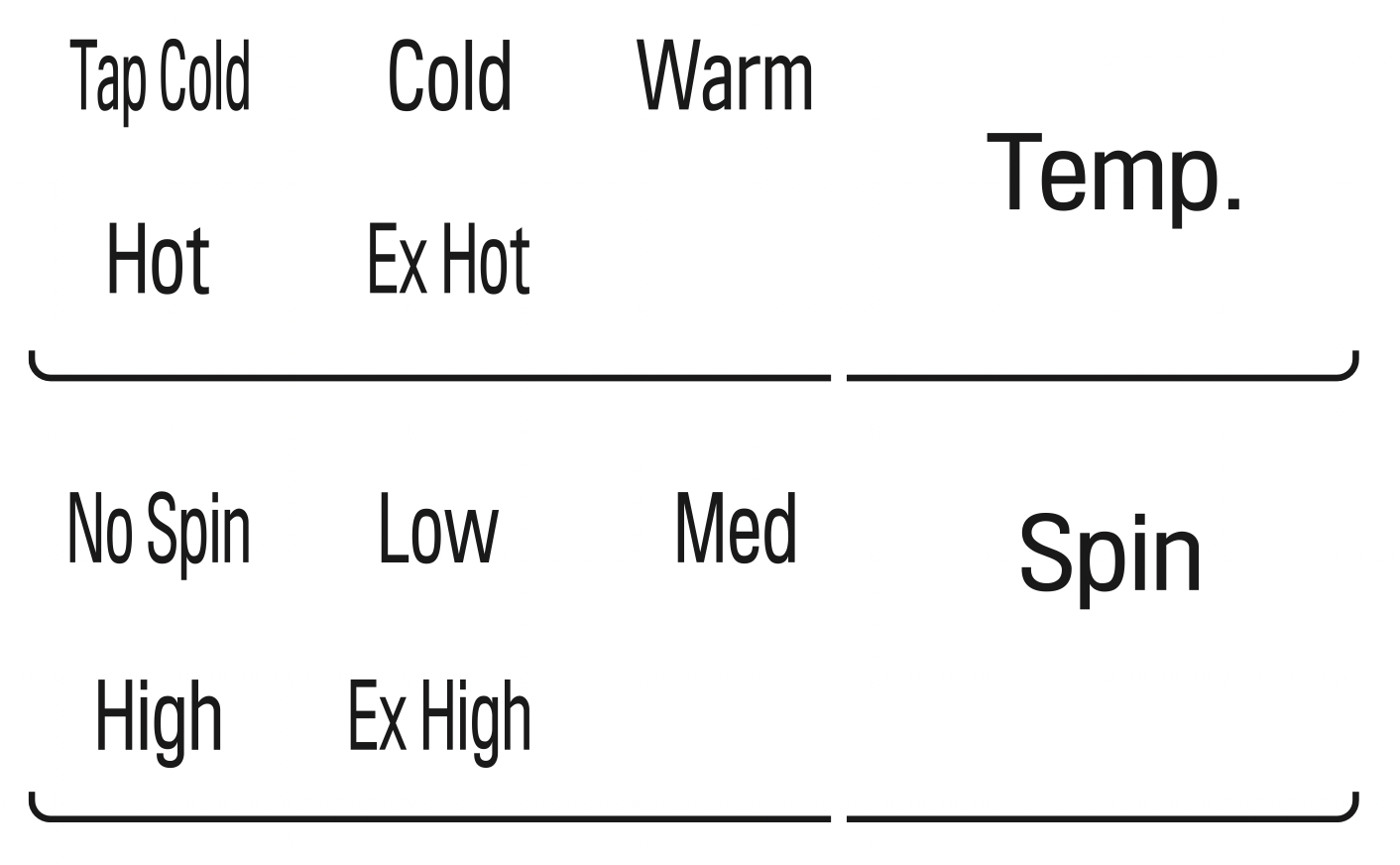
NOTE
- The setting lights up when it is selected.
- To protect your garments, not every wash temperature, spin speed, soil level, or option is available with every cycle.
- A chime will sound twice and the LED will not light if the desired setting is not allowed for the selected cycle.
- Follow the fabric care labels on the garment for best results.
Temp.
Make sure the wash temperature is suitable for the type of load you are washing.
- Press the Temp. button repeatedly to select the wash and rinse temperature combination for the selected cycle.
- All rinses use unheated cold water.
- Cold rinses use less energy. The actual cold rinse temperature depends on the temperature of the cold water at the faucet.
- Your washer features a heating element to boost the hot water temperature for Ex Hot settings. This provides improved wash performance at normal water heater settings.
Spin
Higher spin speeds extract more water from clothes, reducing drying time and saving energy.
- Press the Spin button repeatedly until the desired speed is selected.
- Some fabrics, such as delicates, require a slower spin speed.
Dry Cycles
General Tips for Drying
Use the automatic cycles to dry most loads. Electronic sensors measure the temperature of the exhaust to increase or decrease drying temperatures for faster reaction time and tighter temperature control.
- Use the Wash+Dry cycle to automatically wash and dry laundry.
- For better drying results, make sure all items are similar in material and thickness.
- Do not overload the appliance by stuffing too many articles into the drum. Items must be able to tumble freely.
- If you open the door and remove the load before the appliance has finished its cycle, remember to press the Start/Pause button.
- After the end of dry, ENd is displayed.
Woolen Articles
Do not tumble dry woolen articles. Pull them to their original shape and dry them flat.
Woven and Loopknit Materials
Some woven and loopknit materials may shrink, by varying amounts, depending on their quality.
Always stretch these materials out immediately after drying.
Permanent Press and Synthetics
Do not overload your appliance. Take out permanent press articles as soon as the appliance stops to reduce wrinkles.
Baby Clothes and Nightgowns
Always check the manufacturer’s instructions.
Blankets and Duvets
Check fabric care labels on blankets and duvets before using the drying cycle. Heated drying may cause some blankets and duvets to shrink.
Rubber and Plastics
Do not dry any items made from or containing rubber or plastics, such as:
- Aprons, bibs, chair covers
- Curtains and tablecloths
- Bath mats
Fiberglass
Do not dry fiberglass articles in the appliance. Glass particles left in the appliance may be picked up by your clothes and cause skin irritation.
NOTE
- It is normal for the dryer fan motor to run for about 60 seconds after the dry cycle is stopped.
- Be careful when removing your clothing from the appliance, as the clothing or appliance may be hot.
- The estimated drying time varies from the actual drying time for sensor dry cycles. The type of fabric, size of the load, and the dryness selected affect drying time.
- The Dry Only cycle begins by spinning the clothing to extract water and save energy.
Using Dry Cycles
Press the Dry button repeatedly to select a dry cycle.
Normal ( )
)
Reduces the drying time and energy usage during the dry cycle.
- Fabric Type: Cotton or linen fabrics such as cotton towels, t-shirts, and linen clothing.
Damp Dry ( )
)
Leaves clothes slightly damp for easier ironing.
- Fabric Type: Cotton or linen fabrics, ready to iron at the end of cycle.
Low Temperature ( )
)
Uses low temperature drying to protect clothing.
- Fabric Type: Easy care or permanent press fabrics.
Energy Saver ( )
)
Heated air-condensing dry that saves water.
- Fabric Type: Cotton or linen fabrics such as cotton towels, t-shirts, and linen clothing.
Time 30/60/120 minutes
Select the drying time according to the load size.
- Fabric Type: Cotton, towels
NOTE:
- The capacity of the machine for washing clothes is twice as much as when drying clothes. If the machine is to be used to dry a load, then the wash load must be smaller for effective drying performance. If a full load is washed, remove half the clothes prior to starting the dry cycle.
- All dry cycles begin with a brief spin cycle to extract as much moisture as possible from the load before drying.
Using a Wash and Dry Function
- Prepare the laundry and load the drum.
For consistently dry loads, all articles in the load should be similar in material and thickness.
Do not overload the drum. Items must have room to tumble freely. - Press the Power button.
- Select a wash cycle.
- Add detergent.
- Press the Dry button repeatedly to toggle through the selections:
Normal ( ) - For general drying
) - For general drying
Damp Dry ( ) - For damp drying items for ironing
) - For damp drying items for ironing
Low Temperature ( ) - For delicate fabrics
) - For delicate fabrics
Energy Saver ( ) - For heavier fabrics
) - For heavier fabrics
Time 30/60/120 minutes - For timed drying - Press the Start/Pause button.
Only Using a Dry Function
- Prepare the laundry and load the drum.
For consistently dry loads, all articles in the load should be similar in material and thickness.
Do not overload the drum. Items must have room to tumble freely. - Press the Power button.
Do not select the wash cycle. - Press the Dry button repeatedly to toggle through the selections:
Normal ( ) - For general drying
) - For general drying
Damp Dry ( ) - For damp drying items for ironing
) - For damp drying items for ironing
Low Temperature ( ) - For delicate fabrics
) - For delicate fabrics
Energy Saver ( ) - For heavier fabrics
) - For heavier fabrics
Time 30/60/120 minutes - For timed drying - Press the Start/Pause button.
NOTE: If you turn the cycle selector knob, you will be unable to select a dry only cycle. If this occurs, press Power twice to cycle the machine off and back on.
Waterless Dry Option
This option uses a heated, air-condensing dry without using the water normally used for condensing.
- Prepare the laundry and load the drum.
For consistently dry loads, all articles in the load should be similar in material and thickness.
Do not overload the drum. Items must have room to tumble freely. - Press the Power button.
- Select a dry cycle.
- Press and hold the Dry button for 3 seconds.
- Press the Start/Pause button.
NOTE: A little amount of water is used to wash the lint filter included in the drying module of this product
Options and Extra Functions
Your washer includes several additional cycle options to customize cycles to meet your individual needs.
- Select the desired option after selecting the desired cycle and settings.
NOTE
- The LED for the option will light when the option is selected.
- To protect your garments, not every option is available with every cycle.
- A chime will sound twice and the LED will not light if the selected option is not allowed for the selected cycle.
Steam
Adding this option to a wash cycle helps provide superior cleaning performance. Using steam gives fabrics the cleaning benefits of a very hot wash.
- Steam may not be clearly visible during steam cycles. This is normal. Too much steam could damage clothing.
- Do not use steam with delicate fabrics such as wool and silk, or easily discolored fabrics.
WARNING
- Do not touch the door during steam cycles. The door surface can become very hot and can cause severe burns. Allow the door lock to release before opening the door.
- Do not attempt to override the door lock mechanism or reach into the washer during a steam cycle. Steam can cause severe burns.
Wrinkle Care
This option adds steam after the spin to reduce wrinkles.
- Turn on the power.
- Select the desired cycle.
- Press and hold the Steam button for 3 seconds to select this function.
- Press the Start/Pause or Power button at any time to unload laundry.
Using the Pre-wash Option
This option adds a pre-wash (for about 15 - 17 minutes) for improved cleaning of heavily soiled or stained clothing.
- Press and hold the TurboWash TM and Dry buttons at the same time for 3 seconds.
- The indicator (
 ) lights up.
) lights up.
- The indicator (
Remote Start
Use a smartphone to control your washer remotely.
- For more information, see SMART FUNCTIONS in this manual.
Delay Wash
Once you have selected the cycle and other settings, press the Delay Wash button to delay the start of the wash cycle.
- Each press of this button increases the delay time by 1 hour, for up to 19 hours.
- Once the desired delay time is set, press the Start/Pause button to start the delay time.
NOTE: If the Start/Pause button is not pressed to begin the delay time, the washer automatically turns off after a certain time and all cycle settings are lost.
Wi-Fi
When the washer is connected to a home Wi-Fi network, the  icon on the control panel is lit.
icon on the control panel is lit.
- To connect the washer to the LG ThinQ application, press and hold the Delay Wash button for 3 seconds.
Extra Rinse
This option adds an extra rinse to the selected cycle. Use this option to help ensure the removal of detergent or bleach residue from fabrics.
- Press and hold the TurboWash TM button for 3 seconds to add additional rinses to the cycle.
TurboWashTM
Adding this option reduces the cycle time while still providing similar wash performance to the same cycle without TurboWashTM
Heavy Soil
Select this option to wash heavily soiled laundry with more power than the standard cycle.
- Press the Heavy Soil button to select the option.
Control Lock
Use this function to disable the controls. This function can prevent children from changing cycles or operating this washer.
NOTE
- The function does not lock the door.
- Once this function is set, all buttons are locked except the Power button.
- When the controls are locked,
 and the remaining time are alternately shown on the display during the wash cycle.
and the remaining time are alternately shown on the display during the wash cycle. - Turning off the power will not reset this function.
You must deactivate this function before you can access any other options and functions.
Locking/Unlocking the Control Panel
- Turn on the power.
- Press and hold the Delay Wash and Heavy Soil buttons at the same time for 3 seconds to activate/deactivate this function.
- When the function is deactivated, a chime will sound and the remaining time for the current cycle will reappear on the display.
Signal
The washer plays a melody when the wash cycle is finished. The buttons make a sound each time a button is pressed. Use this button to turn the melody and button tones on or off.
- To turn the function on/off, press and hold the Spin button for 3 seconds.
MAINTENANCE
WARNING
- To reduce the risk of fire, electric shock, or injury to persons, read this entire owner’s manual, including the SAFETY INSTRUCTIONS, before operating this appliance.
- Unplug the appliance before cleaning to avoid the risk of electric shock. Failure to follow this warning can cause serious injury, fire, electric shock, or death.
- Do not use volatile substances (benzene, paint thinner, alcohol, acetone, etc.), abrasive cleaners, or detergents with strong chemical components when cleaning the appliance. Doing so may cause discoloration or damage to the appliance, or may cause a fire.
- Certain internal parts are intentionally not grounded and may present a risk of electric shock only during servicing. Service personnel Do not contact the following parts while the appliance is energized: pump, valve, motor, control board.
Regular Cleaning
Care after Wash
After the cycle is finished, wipe the door and the inside of the door seal to remove any moisture.
- Wipe the body of the washer with a dry cloth to remove any moisture.
- Leave the door open to dry the drum interior.
WARNING: Make sure children and pets do not climb into the drum. Engage the Control Lock feature if needed to prevent children from accidentally starting a wash cycle.
Cleaning the Exterior
Proper care of your washer can extend its life.
Door:
Wash with a damp cloth on the outside and inside and then dry with a soft cloth.
Exterior:
- Immediately wipe off any spills.
- Wipe with a damp cloth.
- Do not touch the surface or the display with sharp objects.
Periodic Maintenance
- Use a towel or soft cloth to wipe around the washer door opening and door glass.
- Always remove items from the washer as soon as the cycle is complete. Leaving damp items in the washer can cause wrinkling, color transfer, and odor.
Cleaning the Drum
Over time, residue may build up in the drum, leading to mildew or a musty odor. Run the Tub Clean cycle monthly to remove residue and prevent odor.
NOTE
- Make sure to run the Tub Clean cycle only when the drum is empty. Never load laundry while using this cycle. The laundry may be damaged or contaminated with cleaning products.
- Run the cycle more often under heavy use conditions or if odor is already present.
- If mildew or musty smell already exists, run this cycle once a week for three consecutive weeks.
- Remove any clothing from the drum.
- Add cleaning agents.
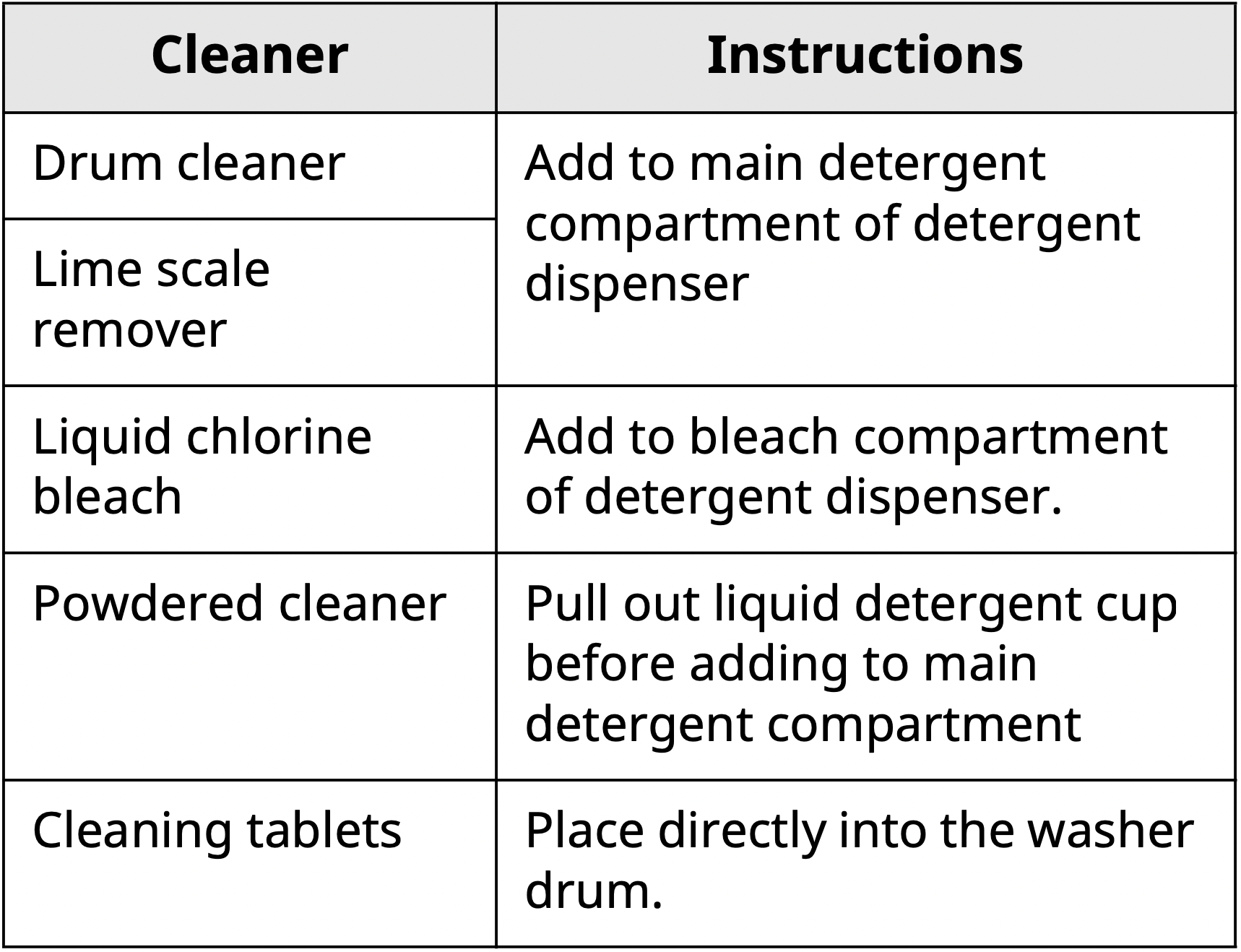
For other drum cleaning products, follow the cleaner manufacturer’s instructions and recommendations.
Do not exceed the maximum fill line when adding bleach or powdered cleaners. Powdered cleaners may remain in the drum after cleaning. - Close the door and press the Power button.
- Select the Tub Clean cycle and press the Start/Pause button to begin the cycle.
- After the cycle ends, open the door and allow the drum interior to dry completely.
WARNING: Make sure children and pets do not climb into the drum. Engage the Control Lock feature if needed to prevent children from accidentally starting a wash cycle.
NOTE: If you use a descaler or drum cleaner during the Tub Clean cycle, use the Rinse+Spin option to rinse the washer drum before running your next wash cycle.
Automatic Alert for Tub Clean
When the power is on and the tcL message blinks on the display, it means the washer drum needs cleaning. Use the Tub Clean cycle to clean the washer drum. The frequency of the automatic alert’s appearance depends on how often the washer is used. However, the message will generally appear every one to two months.
Removing Mineral Buildup
In areas with hard water, mineral scale can form on internal components of the washer. Periodically clean the mineral buildup on the internal components to extend the lifespan of the washer. Use of a water softener is recommended in areas with hard water.
- Use a descaler to remove visible mineral buildup on the washer drum.
- After descaling, always run the Tub Clean cycle before washing clothing.
- Mineral scale and other spots may be removed from the stainless steel drum using a soft cloth soaked in stainless steel cleaner.
- Do not use steel wool or abrasive cleaners.
Leaving the Door Open
After you finish using the washer, leave the door open overnight to allow air to circulate and dry the drum. This helps prevent odors.
Cleaning the Dispenser Drawer
Leaving detergent in the detergent dispenser drawer for an extended period of time or using the washer for a long period of time may cause the build-up of residue in the detergent dispenser drawer. Remove and clean the detergent dispenser drawer once or twice a month.
WARNING: Do not spray water inside the washer. Doing so may cause fire or electric shock.
- Turn off the washer, and unplug the power cord.
- Pull the drawer straight out until it stops.
- Press down hard on the disengage button and pull the drawer completely out.
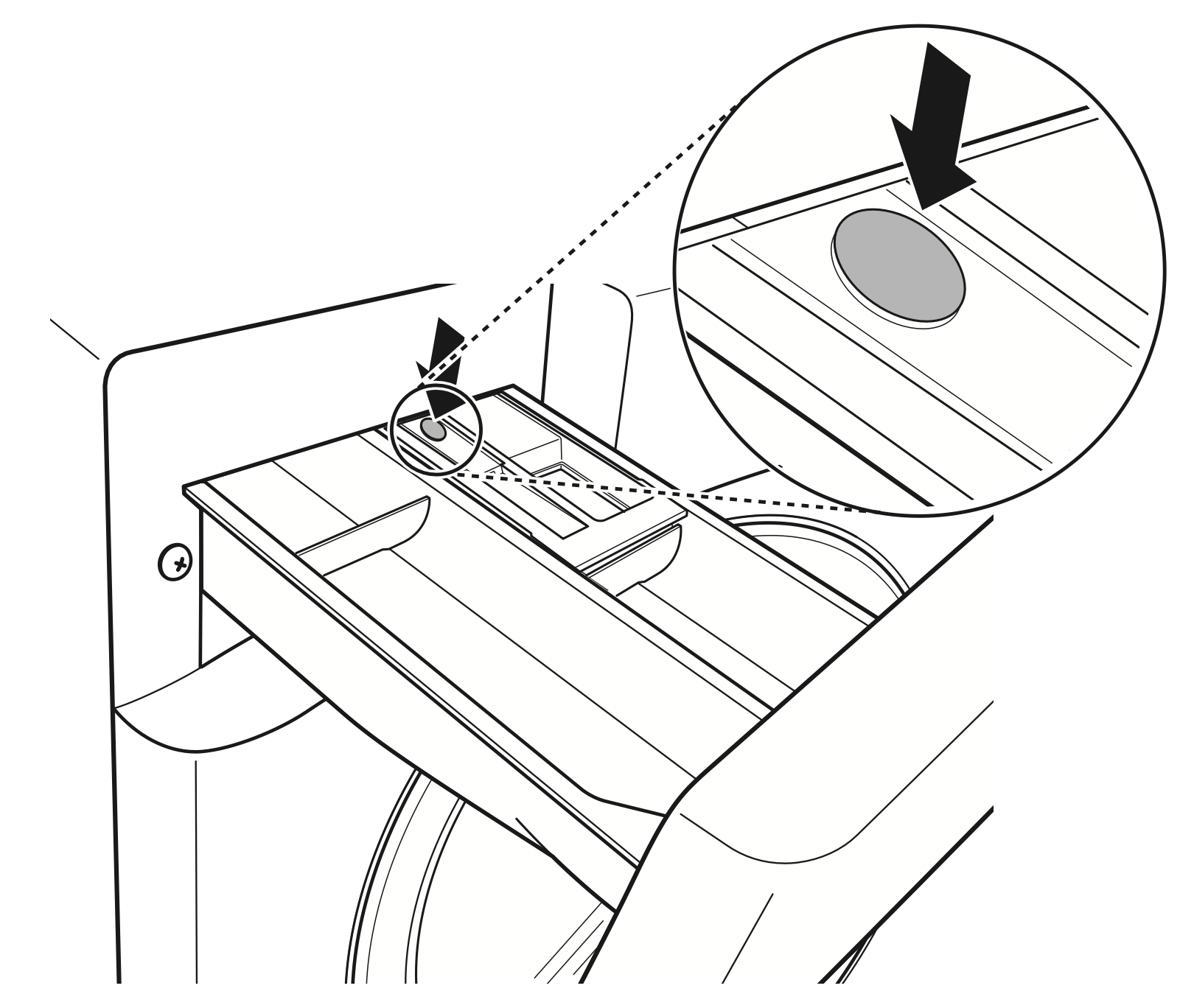
- Remove the inserts from the drawer.
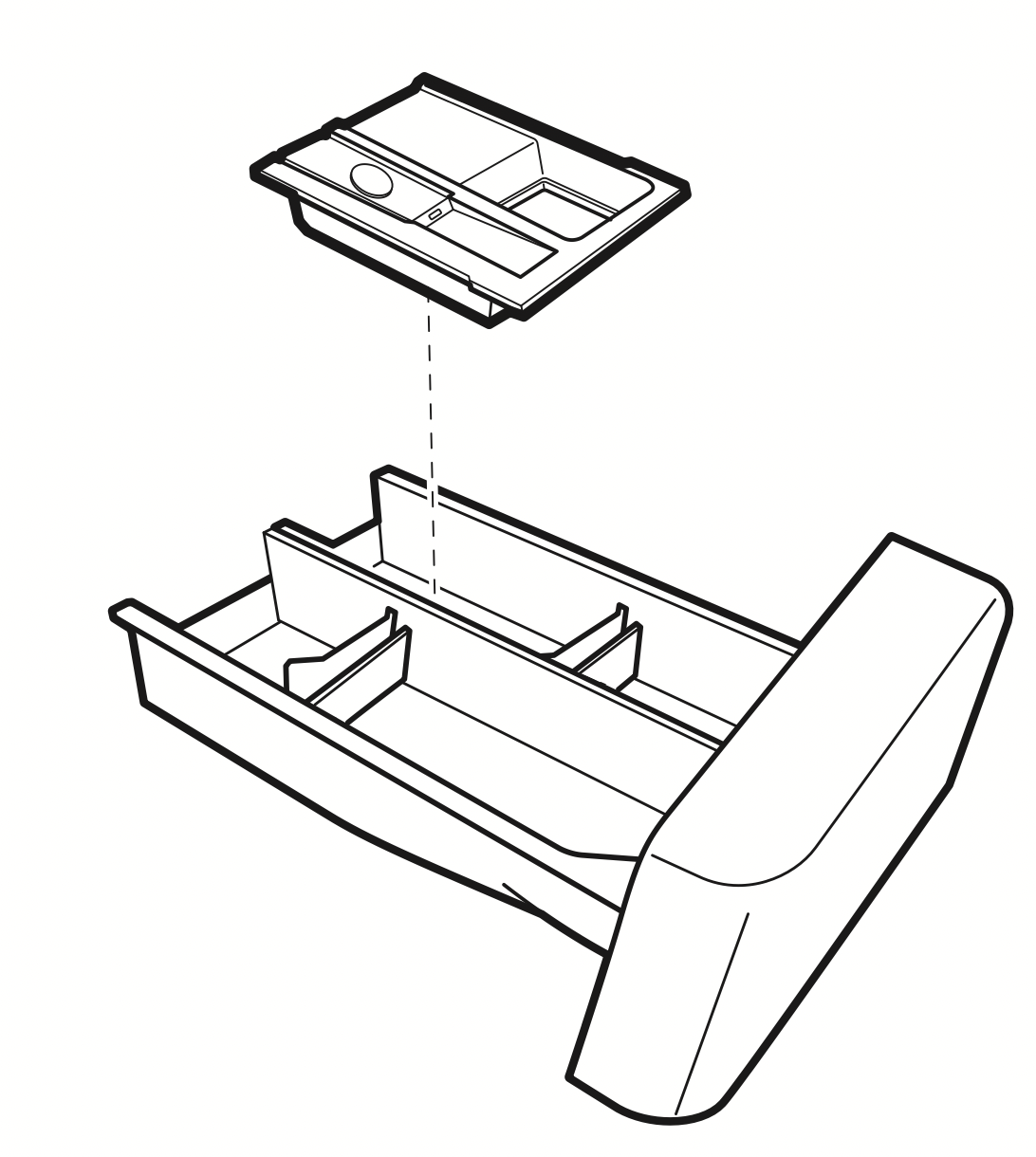
- Clean the inserts and drawer with warm water.
Use a soft cloth or brush to clean and to remove any residue.
Do not use soap when cleaning the drawer and inserts. - Wipe off any moisture with a dry towel or cloth after cleaning.
- To clean the drawer opening, use a small, non-metal brush to clean the recess. Remove all residue from the upper and lower parts of the recess.
- Replace the drawer.
Cleaning the Door Seal
Clean the door seal once a month to prevent build-up of dirt.
CAUTION: Cleaning the door seal with undiluted bleach may cause malfunction of the door seal and washer parts. You must add water to the bleach before using it.
- Wear rubber gloves and protective goggles.
- Dilute 3/4 cup (177 mL) of liquid chlorine bleach in 1 gallon (3.8 L) of water.
- Wipe around the door seal.
Soak a sponge or a soft cloth in this diluted solution and wipe all around the door seal. - Wipe up any moisture with a dry towel or cloth after cleaning.
- Leave the door open to allow the door seal to dry completely.
Cleaning the Water Inlet Filters
If the washer does not fill properly, an error message will appear on the display. The inlet valve filter screens could be clogged by hard water scale, sediment in the water supply, or other debris.
WARNING: The inlet screens protect the delicate parts of the inlet valve from being damaged by particles that could enter the valves with the water supply.
Operating the washer with these filters removed could cause a valve to open continuously, resulting in flooding and/or property damage.
CAUTION
- Do not use the washer without the inlet filters.
- If you use the washer in an area with hard water, the inlet filter may clog due to lime buildup and require more frequent cleaning.
- Turn off the washer, and unplug the power cord.
- Turn off hot and cold water faucets.
- Unscrew the hot and cold water hoses from the back of the washer.
- Remove the filters from the water valves carefully.
Use pliers to pull out the filters from the water valves.
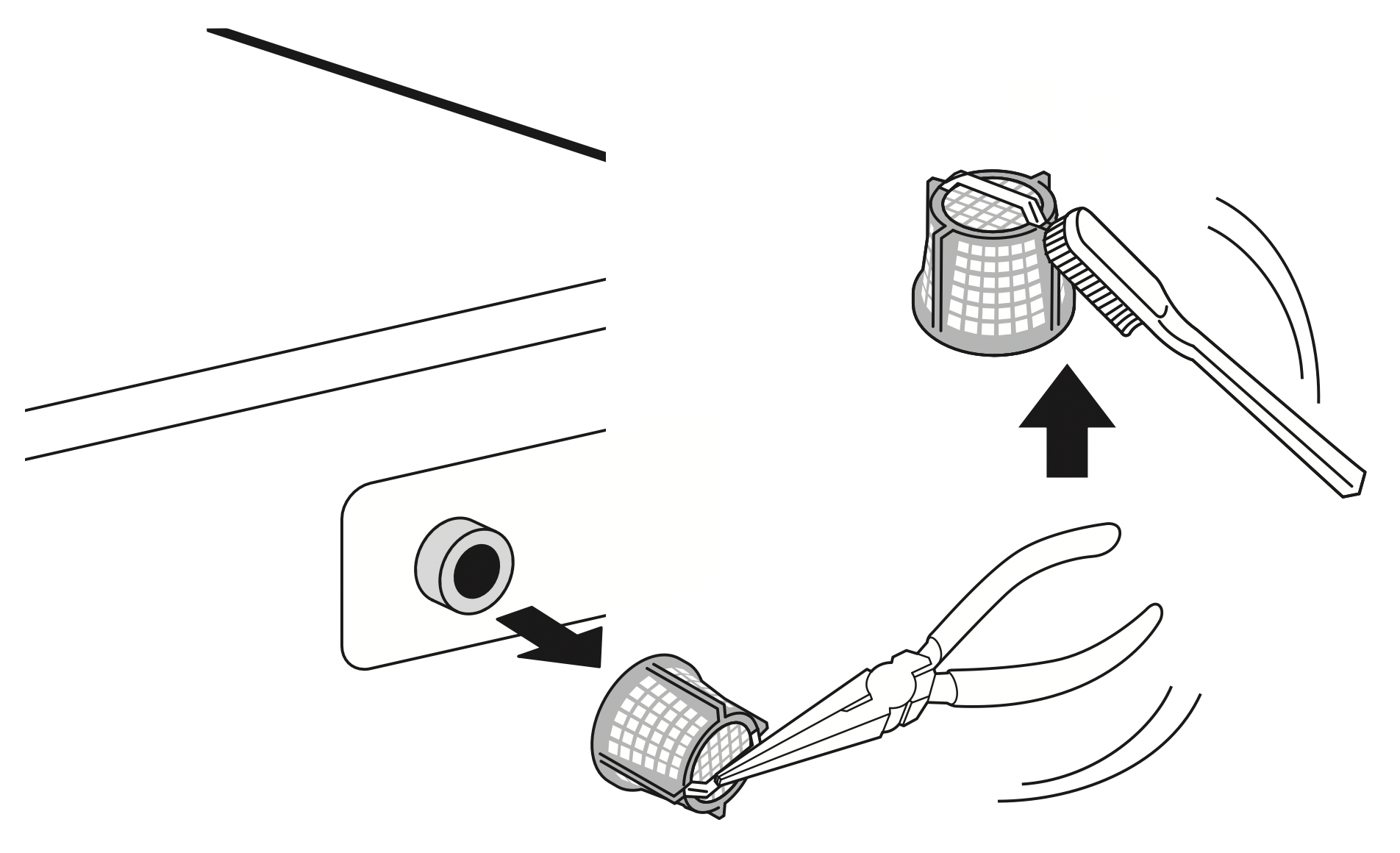
- Remove foreign objects and soak the filters in white vinegar or a lime scale remover.
If using a lime scale remover, follow the manufacturer’s instructions. Be careful not to damage the filters while cleaning them. - Rinse filters thoroughly and press them back into place.
- Flush then reattach the water hoses.
Before reattaching the water inlet hoses, flush them by running several gallons of water through them into a bucket or drain, preferably with the faucets wide open for maximum flow.
NOTE: An  error message may blink on the display when the water pressure is low or an inlet filter is clogged with dirt. Clean the inlet filter.
error message may blink on the display when the water pressure is low or an inlet filter is clogged with dirt. Clean the inlet filter.
Cleaning the Drain Pump Filter
The washer fails to drain if the drain pump filter is clogged. Periodically clean the drain filter to prevent clogging with foreign objects.
WARNING
- Opening the drain filter will result in water overflowing if there is water in the drum. Use a bucket if the drum is not completely drained before you open the drain filter.
- Using the washer without the drain filter or with an incorrectly assembled drain filter may cause leaks or malfunction of the washer.
- Turn off the washer, and unplug the power cord.
- Open the drain pump filter cover.
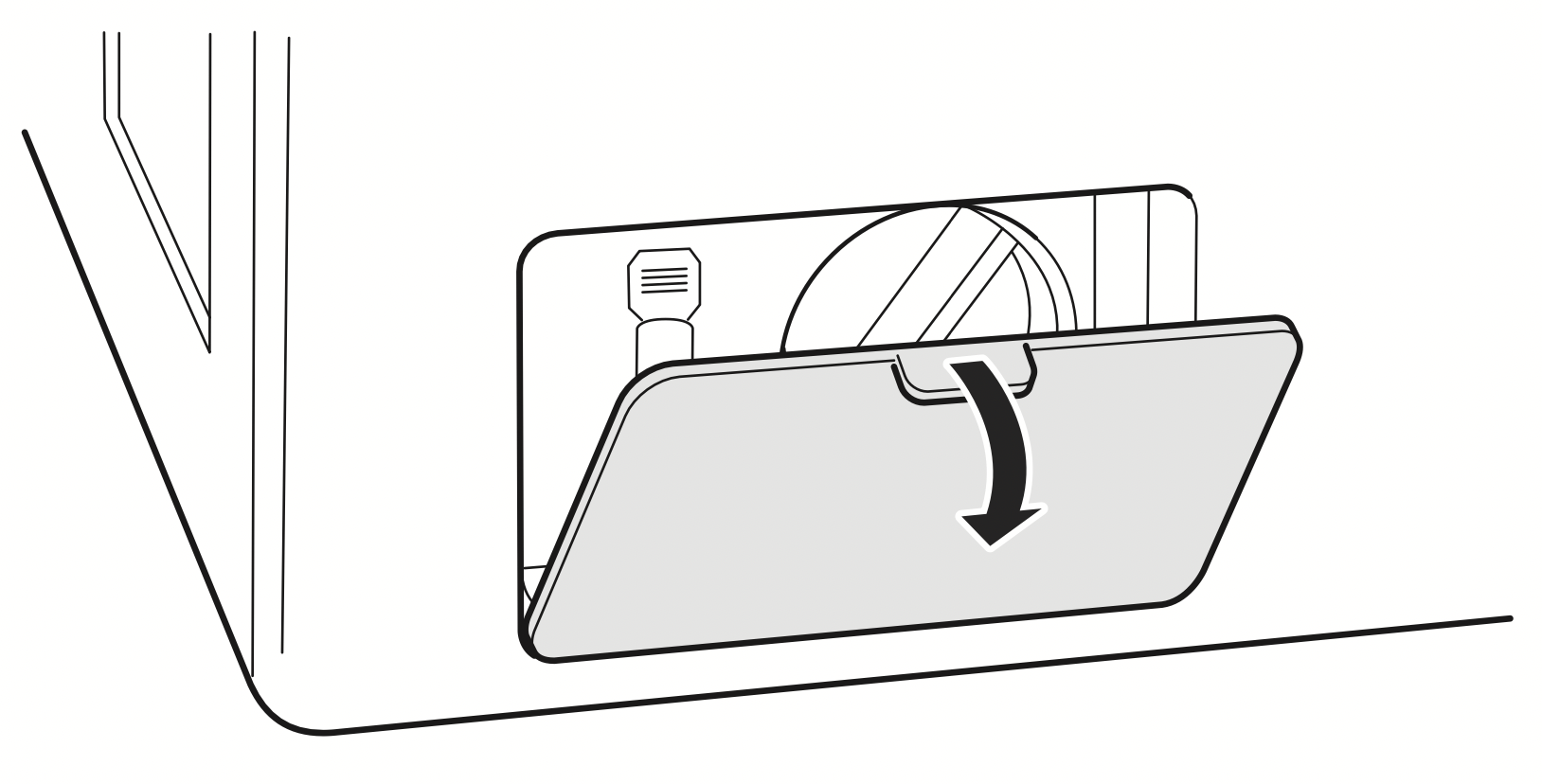
- Drain any remaining water.
Unclip the drain hose and remove the plug from the drain hose to drain the remaining water.
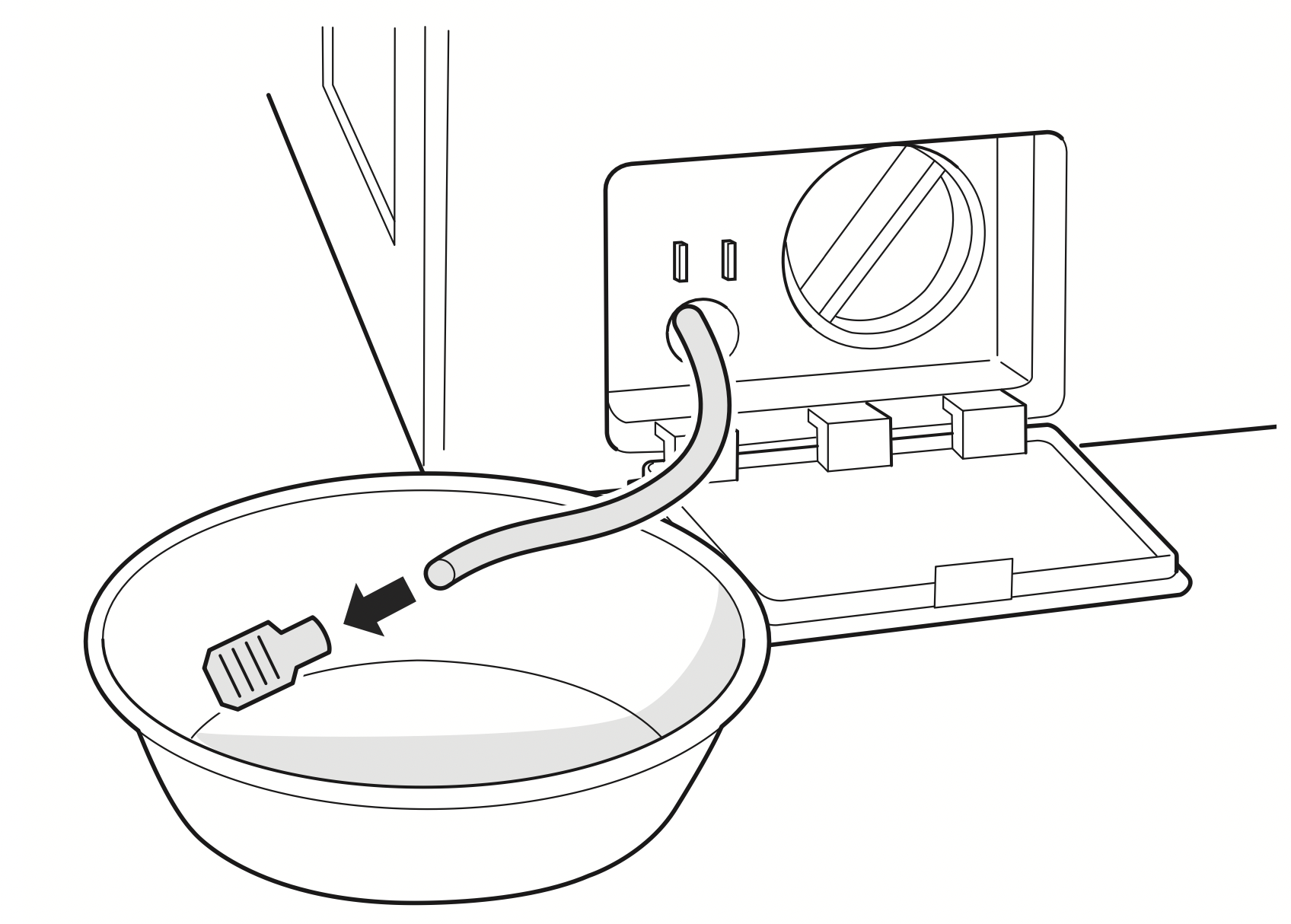
- Remove the pump filter.
Twist the pump filter counterclockwise to remove.
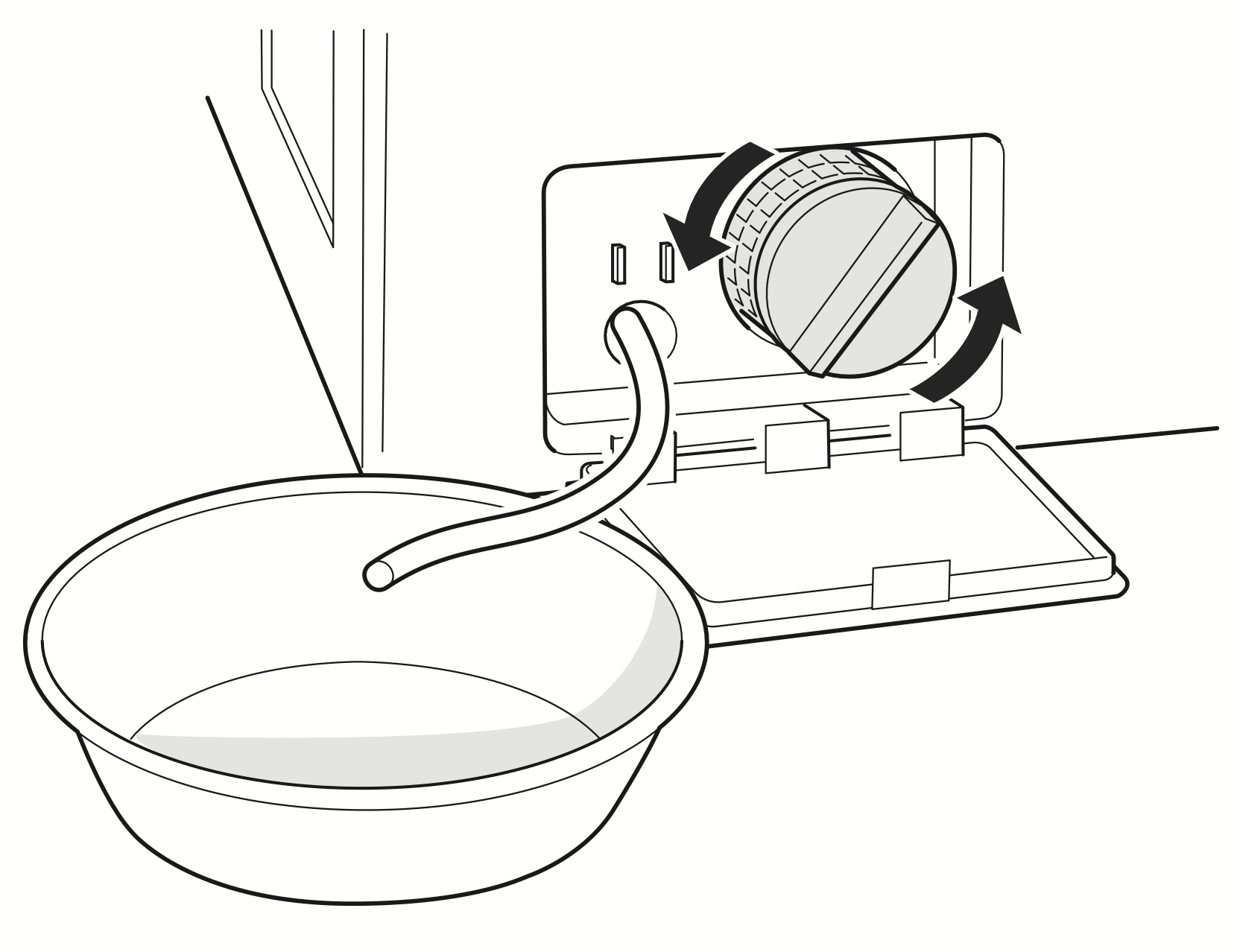
- Clean the pump filter and opening.
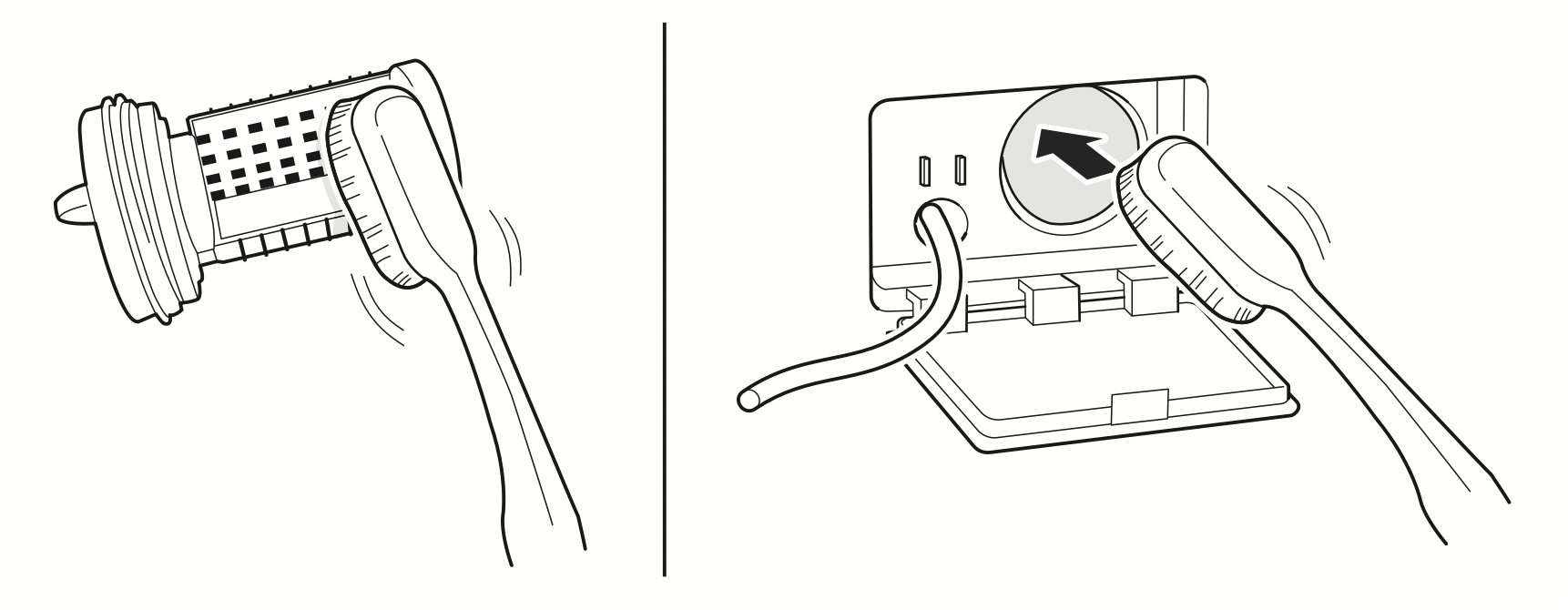
- Reassemble the plug onto the drain hose and reclip the drain hose.
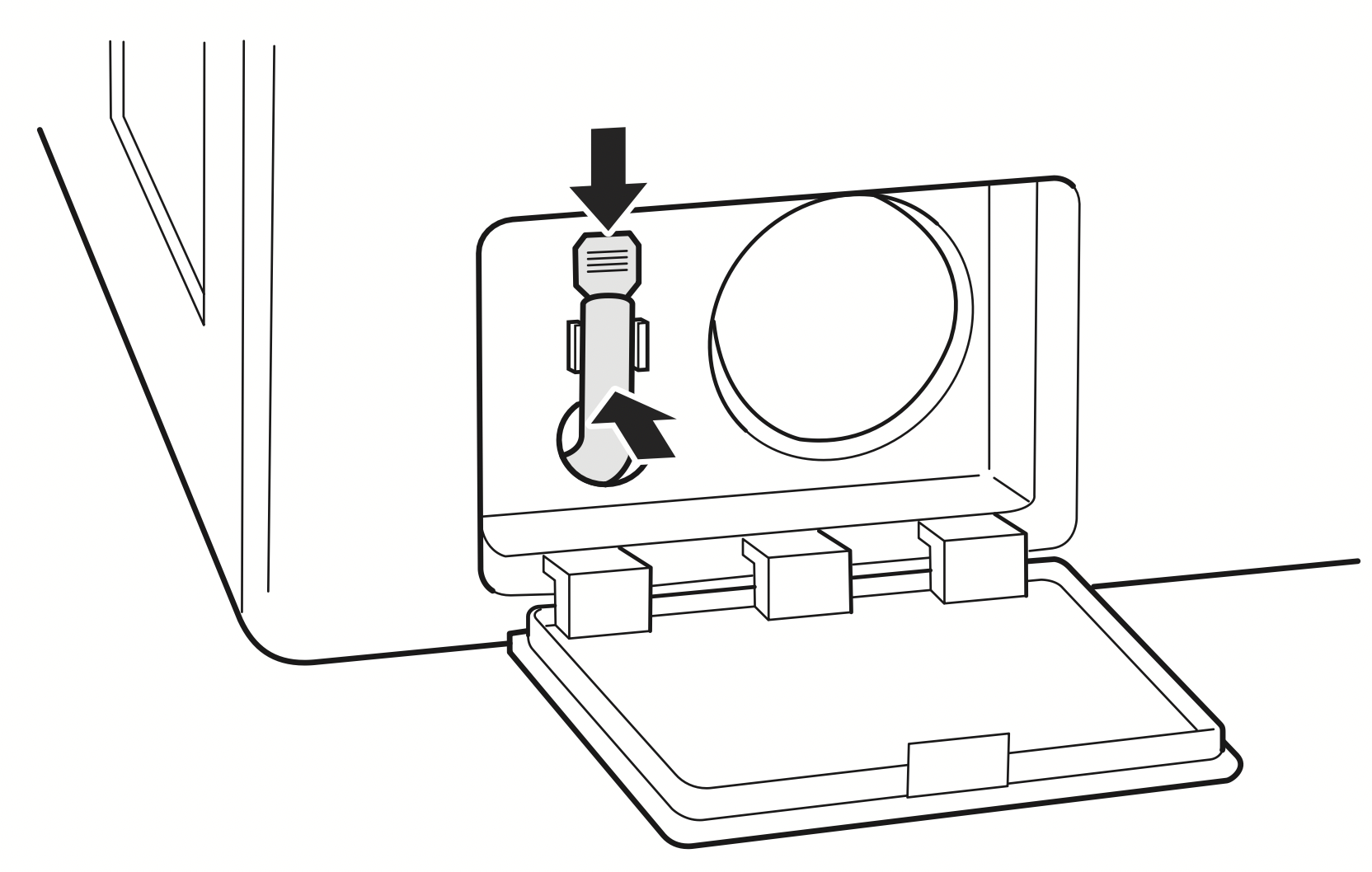
- Insert the drain pump filter and twist it clockwise.
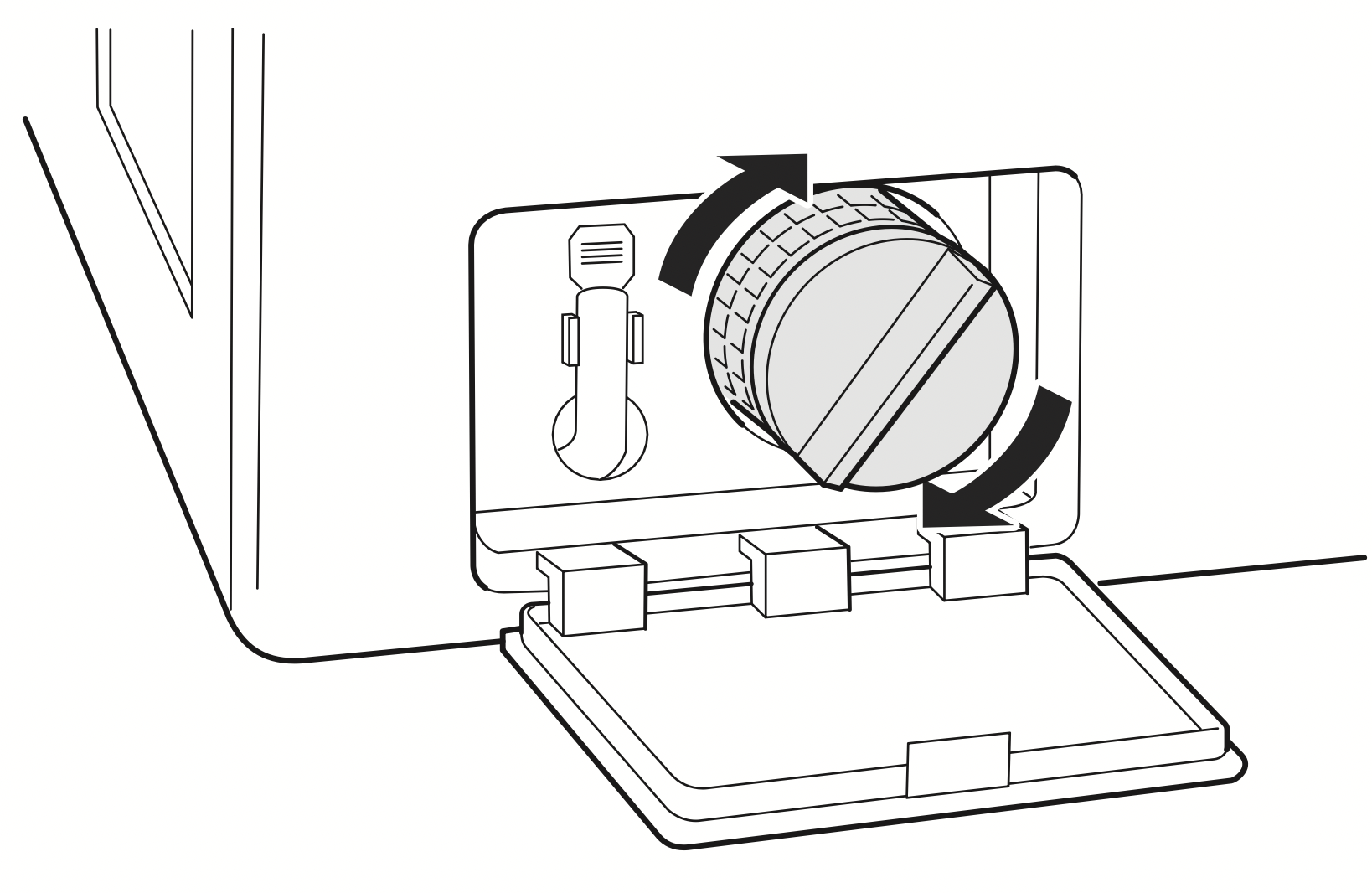
- Close the drain pump filter cover.
NOTE: An  message blinks on the display when the drain pump filter is clogged with dirt. Clean the drain pump filter.
message blinks on the display when the drain pump filter is clogged with dirt. Clean the drain pump filter.
Care in Cold Climates
Storing the Washer
If the washer will not be used for an extended period of time and is in an area that could be exposed to freezing temperatures, follow these steps to protect the washer from damage.
NOTE: Make sure the drum is empty before following these steps.
- Turn off the washer, and unplug the power cord.
- Turn off the water faucets.
- Disconnect the water inlet hoses. Drain any water from the hoses.
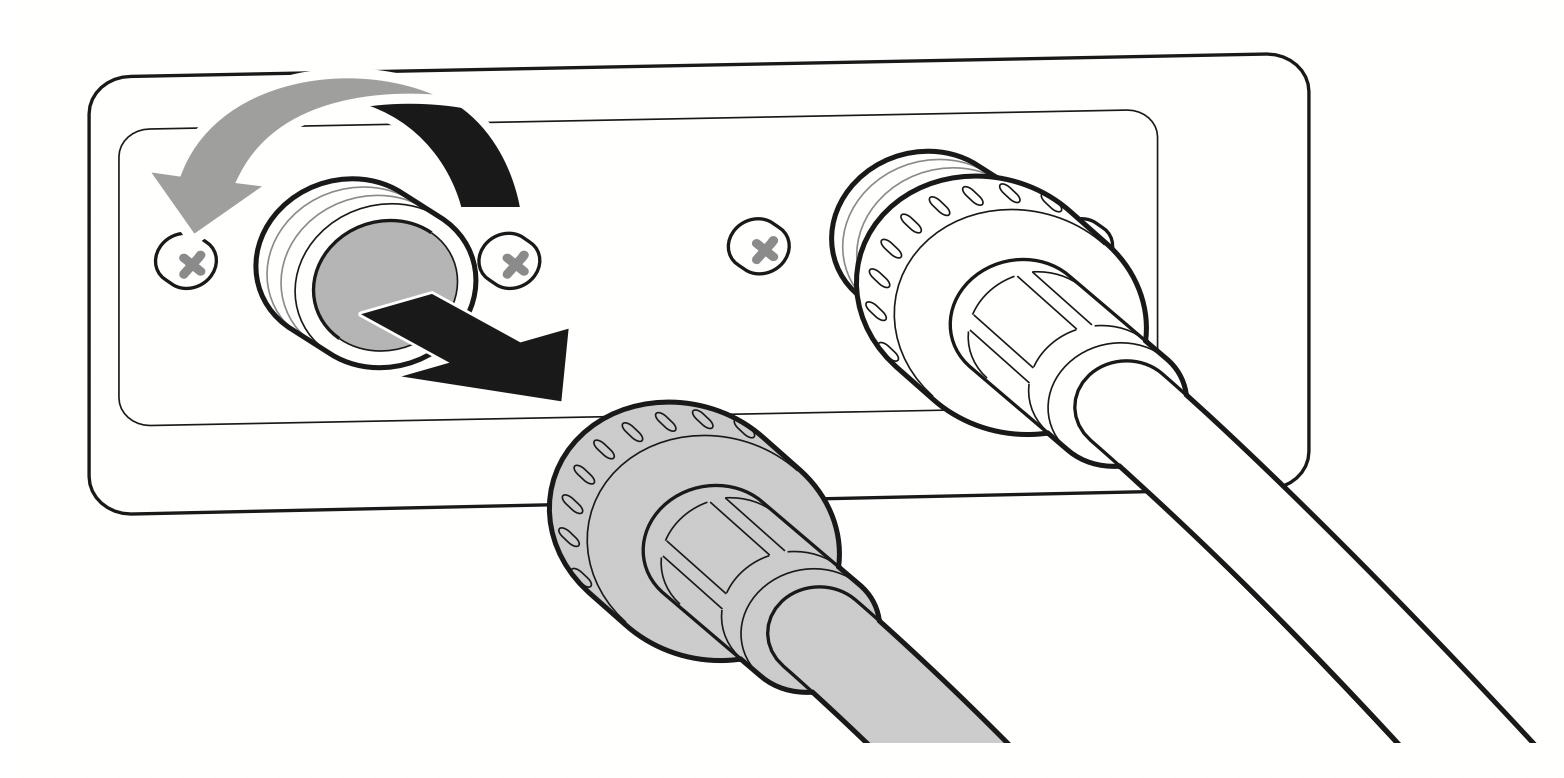
- Plug the power cord into a properly grounded electrical outlet.
- Add 1 gallon of nontoxic recreational vehicle (RV) antifreeze to the empty drum and close the door.
Never use automotive antifreeze. - Turn on the washer and press the Spin button.
- Press the Start/Pause button to start the drain pump for 1 minute.
This will expel some of the antifreeze, leaving enough to protect the washer from damage. - Turn off the washer and unplug the power cord.
- Dry the drum interior with a soft cloth, and close the door
- Store the washer in an upright position.
- Remove the inserts from the dispenser. Drain any water in the compartments and let them dry.
- To remove the antifreeze from the washer after storage, run the Rinse+Spin cycle using detergent.
Do not add laundry to this cycle.
When the Water Inlet Hoses are Frozen
- Turn off the washer, and unplug the power cord.
- Turn off the faucets connected to the water inlet hoses.
- Pour hot water on the frozen faucets to thaw the water inlet hoses and remove the water inlet hoses.
- Immerse the water inlet hoses in hot water to thaw them.
- Reconnect the water inlet hoses to the water inlets of the washer and to the faucets.
See Connecting the Water Inlet Hoses for details. - Turn on the faucets.
- Press the Power button to turn on the washer.
- Press the Spin button to operate spin only cycle for draining and spinning.
- Press the Start/Pause button.
When the Drain Hose is Frozen
- Pour hot water in the washer drum and close the door.
- Wait for 1 - 2 hours.
- Press the Power button.
- Press the Spin button to operate spin only cycle for draining and spinning.
- Press the Start/Pause button to make sure the water drains.
TROUBLESHOOTING
Before Calling for Service
The washer is equipped with an automatic error-monitoring system to detect and diagnose problems at an early stage. If the washer does not function properly or does not function at all, check the following before you call for service.
FAQs
Q: Why does my washer make loud banging noises while it is filling with water?
A: This is actually a problem with the plumbing in your home. When the water valve in the washer shuts off, it can cause pipes in your home to move, resulting in a loud banging noise. This effect, called water hammer, can be reduced by installing an item called a water hammer arrestor. Add-on arrestors can be purchased through your local hardware or home improvement store.
Q: Why is there so little water in my washer? How can it clean the clothes?
A: HE (High-Efficiency) washers are designed to properly wash your laundry while using a minimum amount of water and energy. Because the water volume is low, the small amount of detergent used is more concentrated in the water, resulting in excellent cleaning performance.
Q: When I press a button, why does my washer beep and then nothing happens?
A: The Control Lock feature is turned on. To turn it off, turn on the washer, then press and hold the button that has Control Lock on or under it for 3 seconds.
Q: Where should I pour the powdered laundry products when doing my laundry?
A: If you are using powdered laundry detergent, load it in the main detergent dispenser after removing the liquid detergent insert. Powdered laundry agents or powdered color safe bleach should be put directly into the drum. These products can be put in the empty drum before loading or on top of the laundry after loading the washer.
Error Messages
| Problem | Possible Cause & Solution |
|---|---|
|
INLET ERROR |
Water supply faucets are not fully open.
|
|
Water inlet hoses are kinked, pinched, or crushed.
|
|
|
Water inlet filters are clogged.
|
|
|
Water supply pressure to faucet or house is too low.
|
|
|
Water supply connected with leak-limiting hoses.
|
|
|
UNBALANCE ERROR |
The load is too small.
|
|
Heavy articles are mixed with lighter items.
|
|
|
The load is out of balance.
|
|
|
DOOR OPEN ERROR |
The door is not secured.
|
|
WATER OUTLET ERROR |
Drain hose is kinked, pinched, or clogged.
|
|
The end of the drain hose is more than 96 inches (2.4 m) above the bottom of the washer.
|
|
|
TEMPERATURE SENSOR ERROR |
Control error.
|
|
OVERFLOW ERROR |
Water level is too high due to a faulty water valve.
|
|
PRESSURE SENSOR ERROR |
The water level sensor is not working correctly.
|
|
MOTOR LOCKED ERROR |
A motor error has occurred.
|
|
FROZEN ERROR |
Inlet hose, drain hose or drain pump is frozen.
|
|
CONTROL LOCK FUNCTION |
The Control Lock function is on to prevent anyone from changing cycles or operating the washer.
|
|
TUB CLEAN ALARM |
It is time to run the Tub Clean cycle.
|
|
VIBRATION SENSOR ERROR |
Vibration sensor malfunctions.
|
|
DRY ERROR |
Dryer function not working (on washer/dryer combination models).
|
Noises
| Problem | Possible Cause & Solution |
|---|---|
| Clicking |
Door lock sounds when the door locks or unlocks.
|
| Spraying or hissing |
Water spraying or circulating during the cycle
|
| Humming or Gurgling |
Drain pump is pumping water from the washer at times during a cycle.
|
| Water sloshing |
A liquid in the balance ring around the pulsator helps the basket spin smoothly.
|
| Water being added after the washer has already begun to operate |
The washer adapts to the load size and type to add more water to the cycle as needed.
|
|
The wash load may be unbalanced. If the washer senses that the load is unbalanced, it will stop and refill to redistribute the load.
|
|
|
The washer may be diluting laundry additives to add to the wash load.
|
|
| Rattling and clanking noise |
Foreign objects, such as keys, coins, or safety pins may be in drum or pump.
|
| Thumping sound |
Heavy wash loads may produce a thumping sound.
|
|
Wash load may be out of balance.
|
|
| Vibrating noise |
Packaging materials were not removed.
|
|
Wash load may be unevenly distributed in the drum.
|
|
|
Not all leveling feet are resting firmly and evenly on the floor.
|
|
|
Floor is not rigid enough.
|
|
| Squeaking noise |
Packaging materials were not removed.
|
| Banging noise when the washer is filling with water. (Water hammer) |
Plumbing in the home moves or flexes when the water valves in the washer shut off.
|
|
Household water supply pressure is very high.
|
Operation
| Problem | Possible Cause & Solution |
|---|---|
| Water Leaking |
Hoses are not connected correctly.
|
|
House drain pipes are clogged.
|
|
|
Drain hose has come out of the drain connector or is not inserted far enough.
|
|
|
Oversudsing of detergent
|
|
| Excessive sudsing |
Too much detergent or incorrect detergent
|
| Washer will not turn on. |
Power cord is not properly plugged in.
|
|
House fuse is blown, circuit breaker has tripped, or power outage has occurred.
|
|
| Wash cycle time is longer than usual. |
The washer automatically adjusts the wash time for the amount of laundry, water pressure and other operating conditions.
|
| Incomplete or no dispensing of detergent |
Detergent compartments clogged from incorrect filling.
|
|
Too much detergent used.
NOTE: Always use as little detergent as possible. HE (High-Efficiency) washers need very little detergent to achieve optimum results. Using too much detergent will cause poor wash and rinse performance and may contribute to odors in the washer. |
|
|
Insufficient water supply
|
|
|
Normal residue
|
|
| Washer will not operate. |
Control panel has powered off due to inactivity.
|
|
Washer is unplugged.
|
|
|
Water supply is turned off.
|
|
|
Controls are not set properly.
|
|
|
Door is open.
|
|
|
Circuit breaker/fuse is tripped/blown.
|
|
|
Start/Pause button was not pressed after the cycle was set.
|
|
|
Extremely low water pressure.
|
|
|
Washer is too cold.
|
|
| Washer is not filling properly. |
Filter is clogged.
|
|
Inlet hoses may be kinked.
|
|
|
Energy efficiency
|
|
|
Insufficient water supply
|
|
|
Washer door is open.
|
|
|
Water level is too low.
|
|
| Water in the washer does not drain or drains slowly. |
Drain hose is kinked, pinched, or clogged.
|
|
The end of the drain hose is more than 96 inches (2.4 m) above the bottom of the washer.
|
Performance
| Problem | Possible Cause & Solution |
|---|---|
| Wrinkling |
Washer is not unloaded promptly.
|
|
Washer is overloaded.
|
|
|
Hot and cold water inlet hoses are reversed.
|
|
| Staining |
Bleach or softener dispensed too soon.
|
|
Bleach or softener was added directly to the wash load in the drum.
|
|
|
Washer was not unloaded promptly.
|
|
|
Clothes were not properly sorted.
|
|
| Poor stain removal |
Proper options are not selected.
|
|
Previously set stains.
|
|
| Musty or mildewy odor in the washer |
Incorrect or too much detergent has been used.
|
|
Inside of the drum was not cleaned properly.
|
Odor
| Problem | Possible Cause & Solution |
|---|---|
|
Odor |
Some odor is caused by the rubber attached to the washing machine.
|
|
If the rubber door gasket and door seal area are not cleaned regularly, odors can occur from mold or foreign substances.
|
|
|
Odors can occur if foreign substances are left in the drainage pump filter.
|
|
|
Odors can occur if the drainage hose is not properly installed, causing siphoning (water flowing back inside the washing machine).
|
|
|
Using the dry function, odors can occur from lint and other laundry matter sticking to the heater. (Dryer model only)
|
|
|
A particular odor can occur from drying wet clothes with hot air. (Dryer model only)
|
Wi-Fi
| Problem | Possible Cause & Solution |
|---|---|
| Trouble connecting appliance and smartphone to Wi-Fi network |
The password for the Wi-Fi network was entered incorrectly.
|
|
Mobile data for your smartphone is turned on.
|
|
|
The wireless network name (SSID) is set incorrectly.
|
|
|
The router frequency is not 2.4 GHz.
|
|
|
The appliance and the router are too far apart.
|













